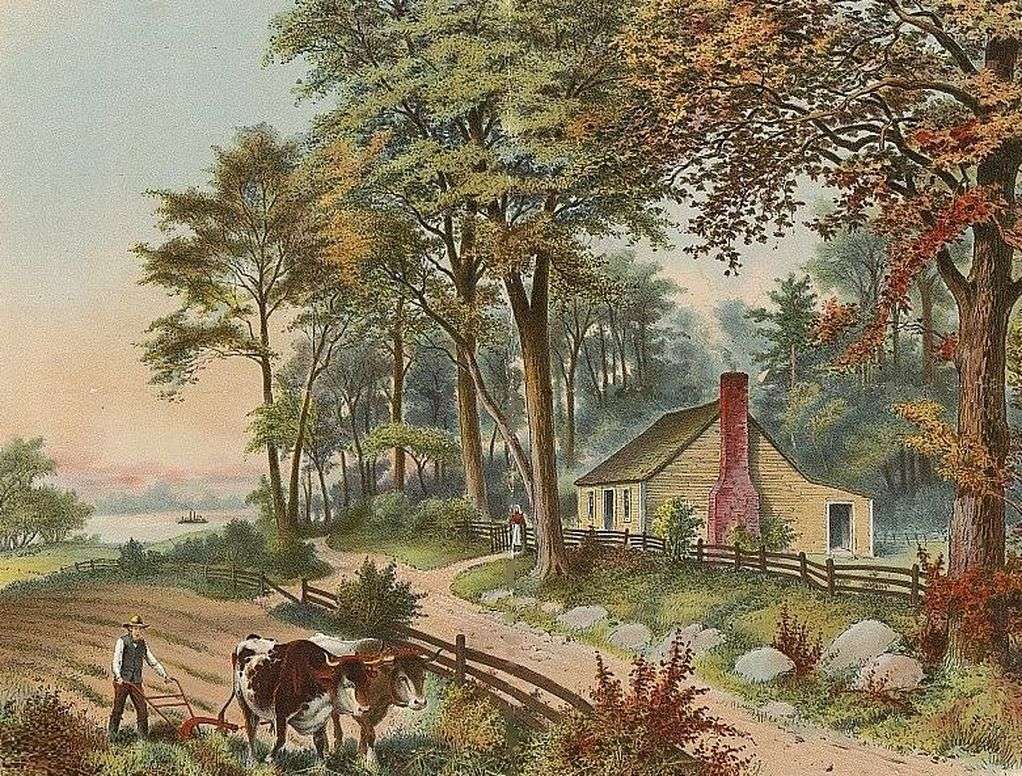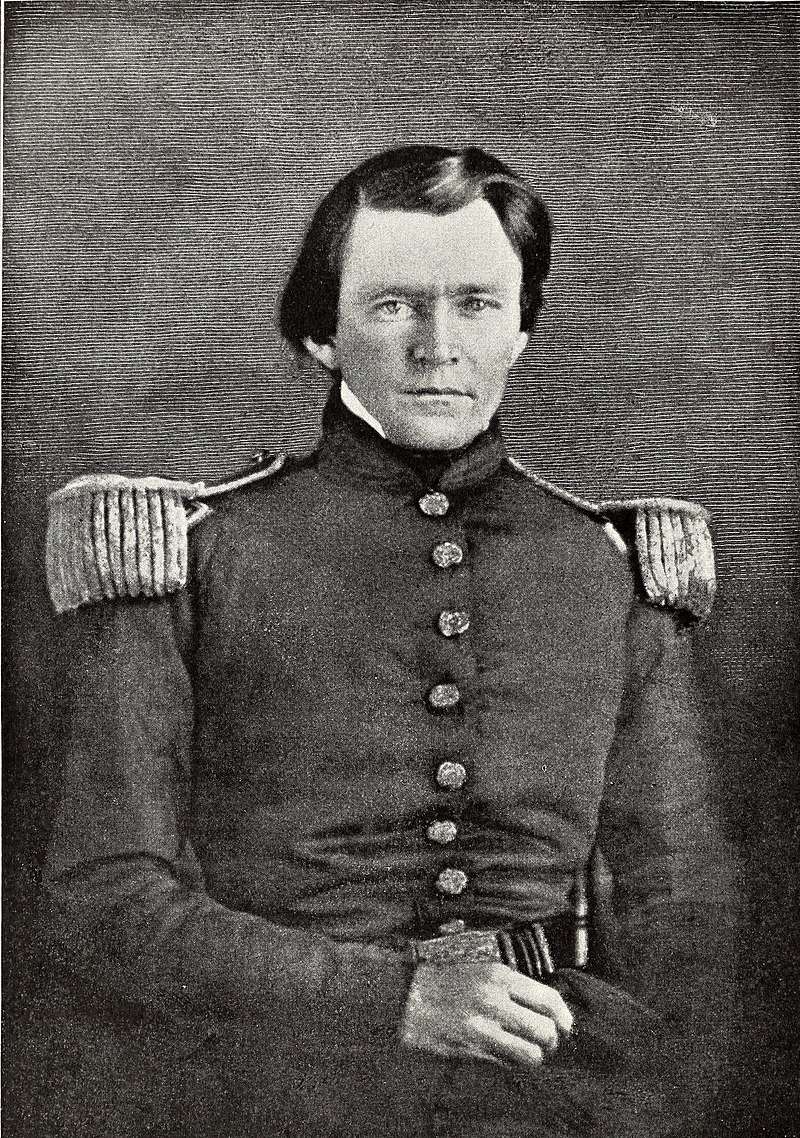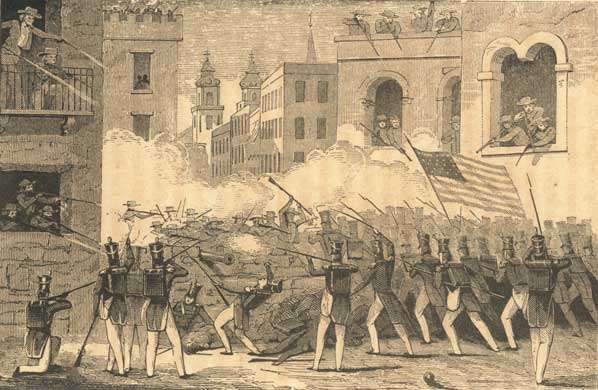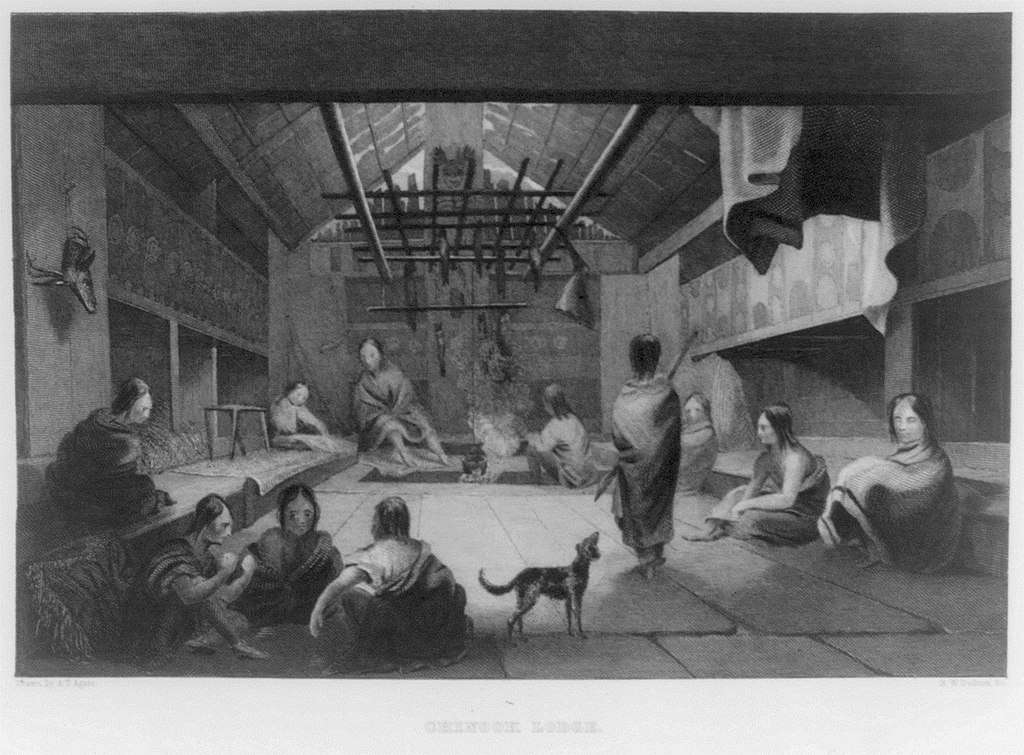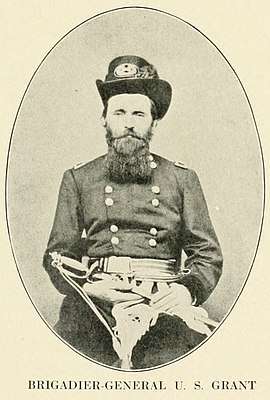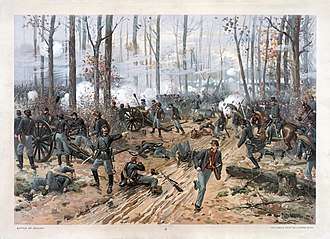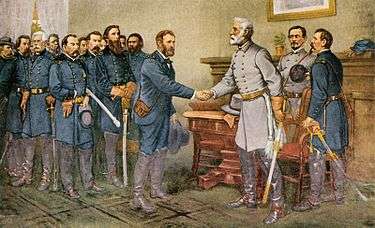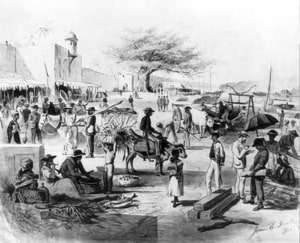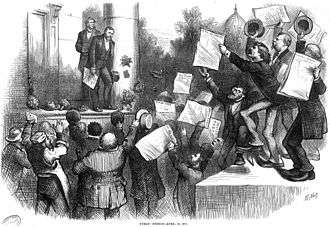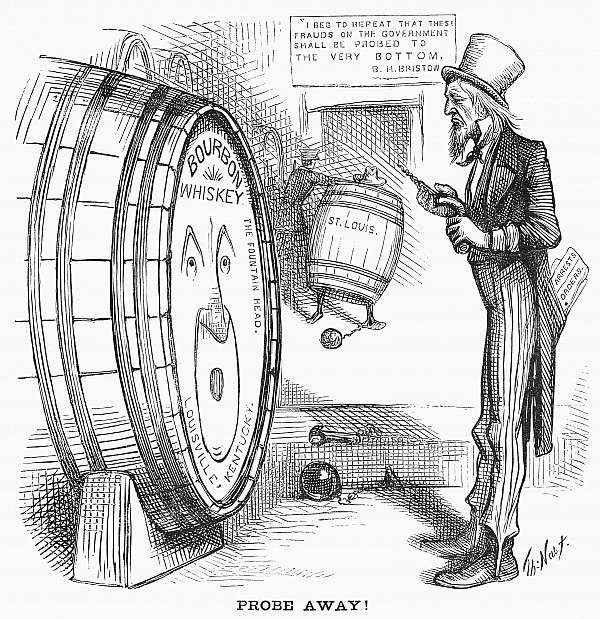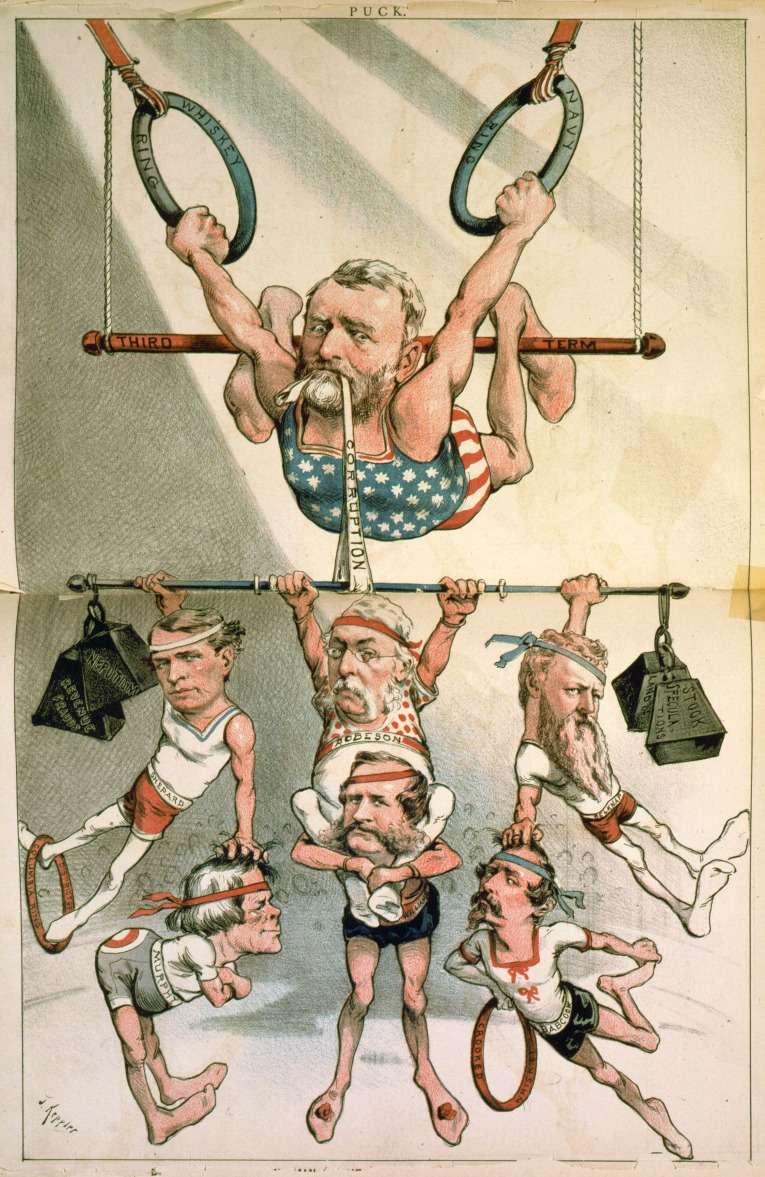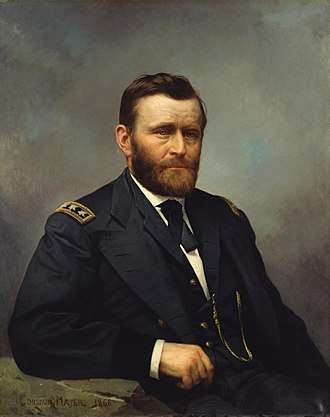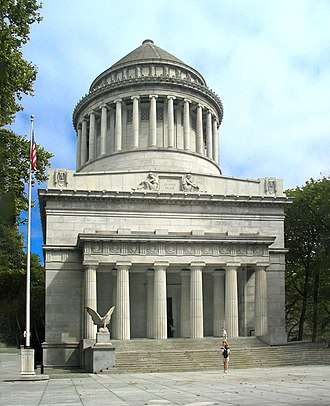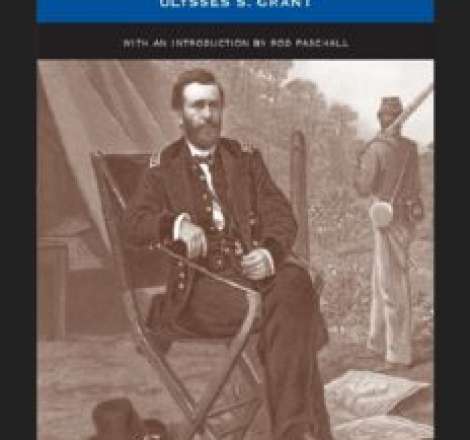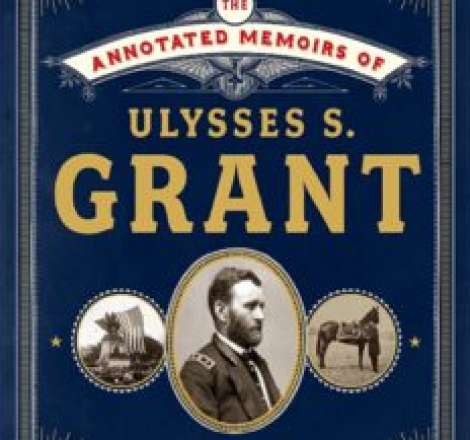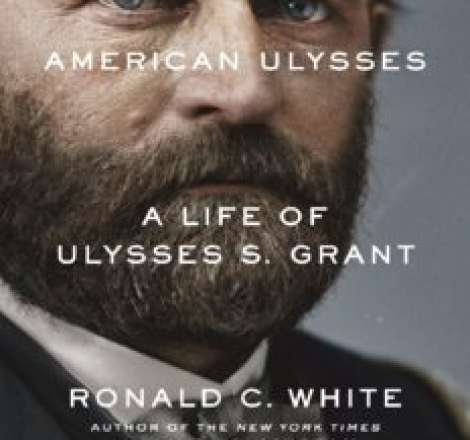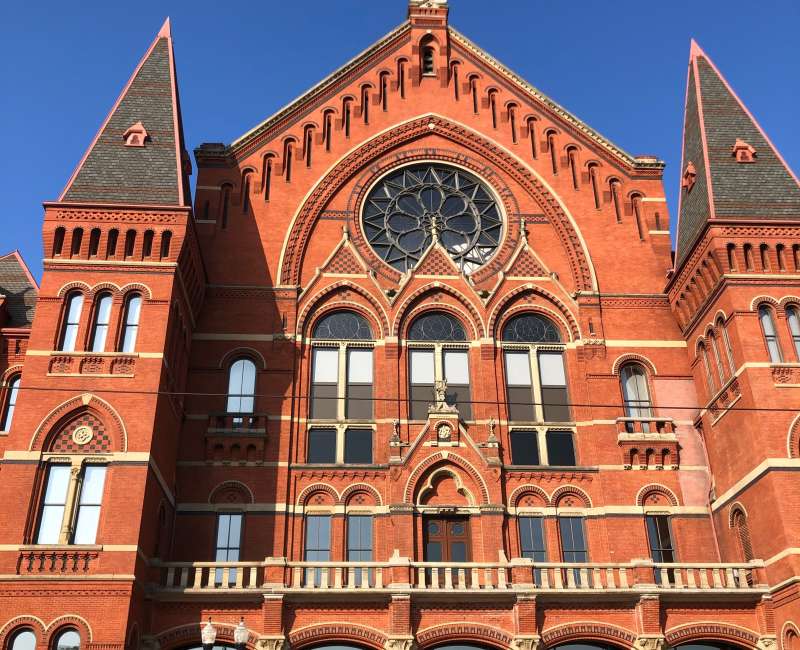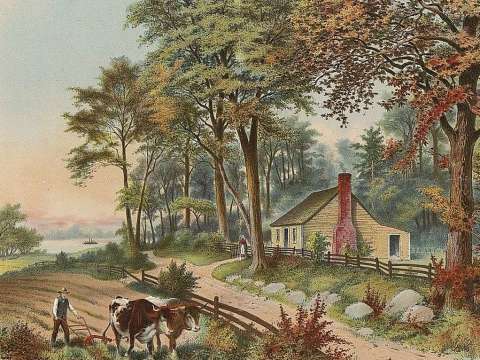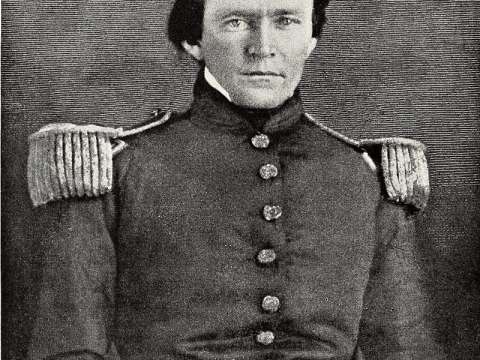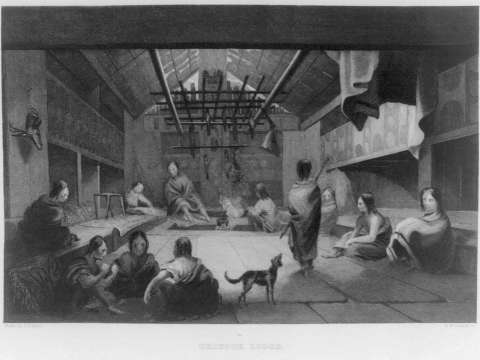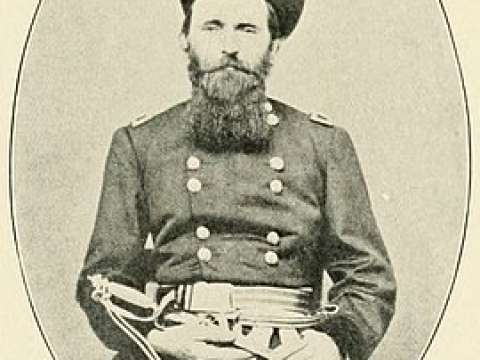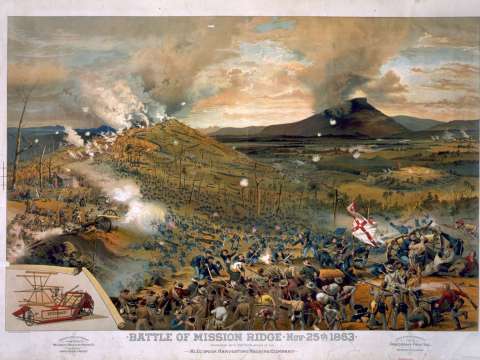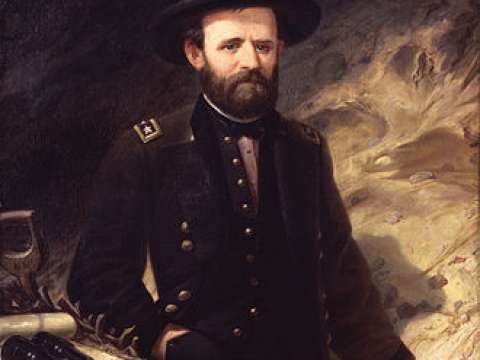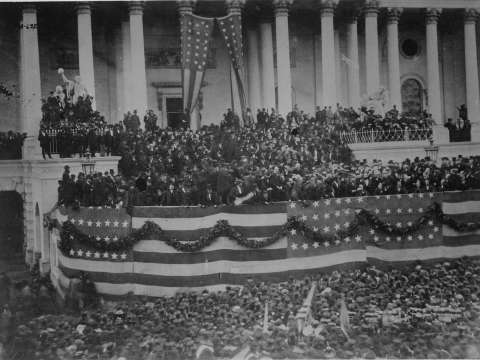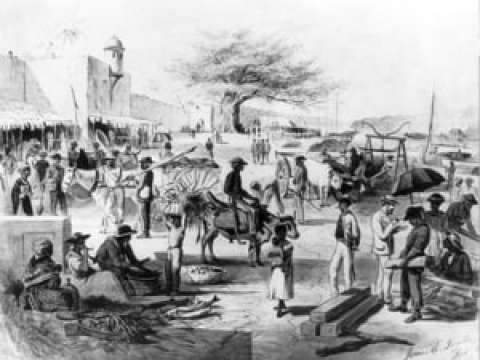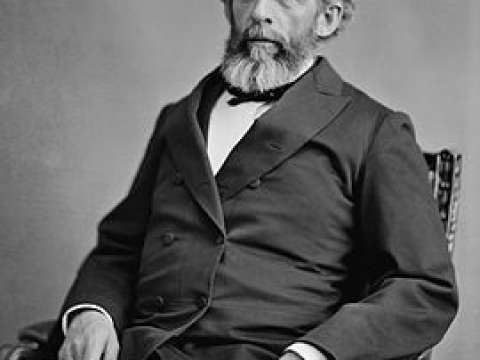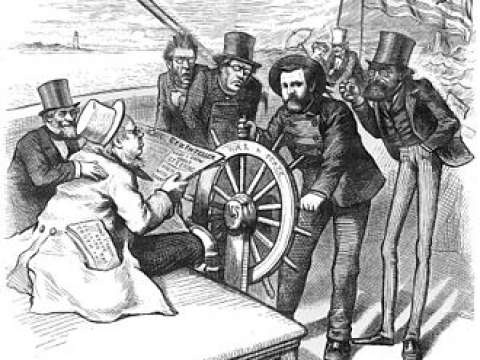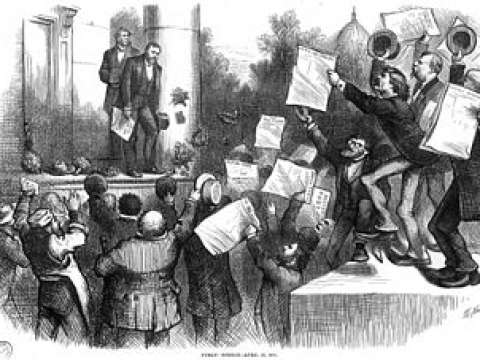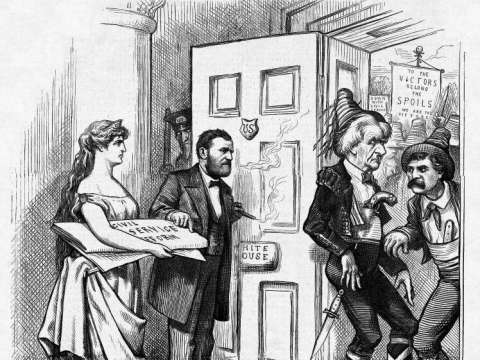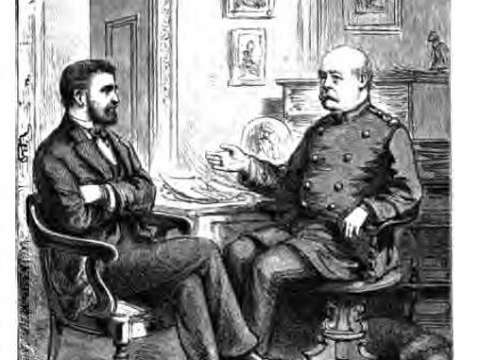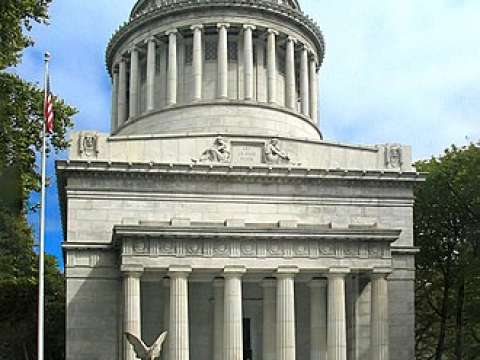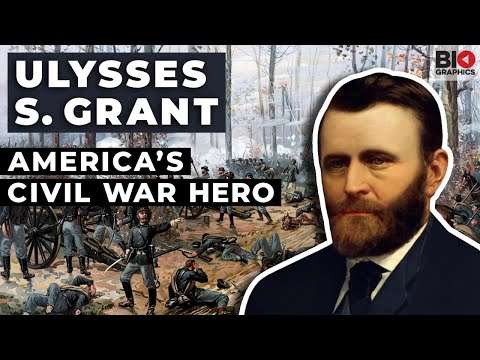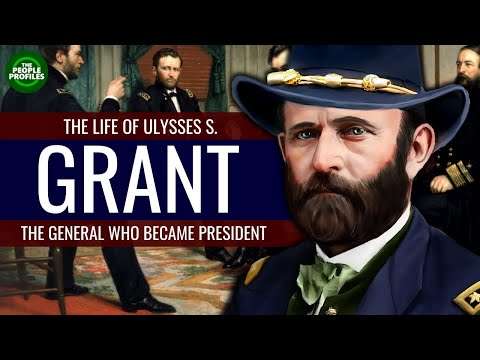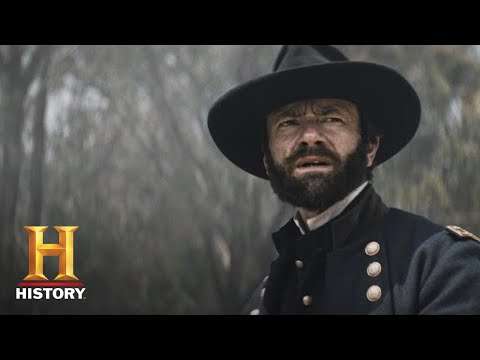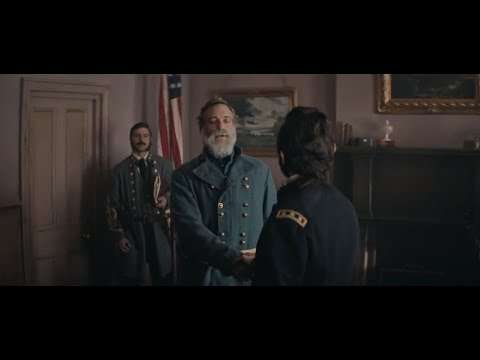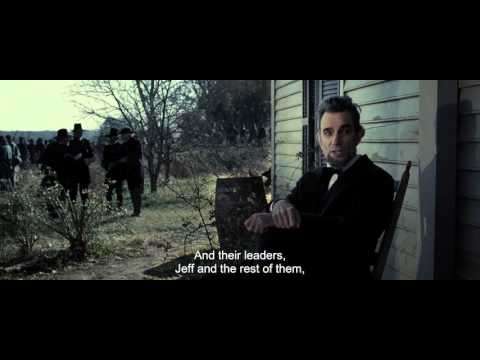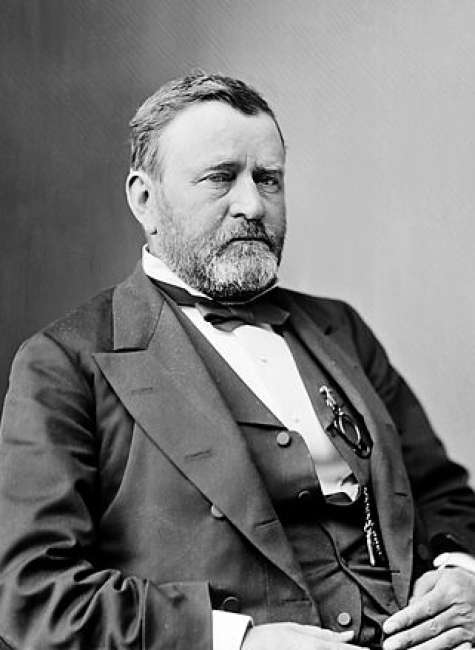

Ulysses S. Grant (1822-1885)

If we are to have another contest in the near future of our national existence, I predict that the dividing line will not be Mason and Dixon's but between patriotism and intelligence on the one side, and superstition, ambition and ignorance on the other.
Ulysses S. Grant (born Hiram Ulysses Grant) was an American soldier and politician who served as the 18th president of the United States from 1869 to 1877. Before his presidency, Grant led the Union Army as Commanding General of the United States Army in winning the American Civil War. As president, Grant was an effective civil rights executive who worked with the Radical Republicans during Reconstruction to protect blacks and reestablish the public credit, while rebuilding the U.S. Navy, that lagged behind other world power navies, such as Spain.
Raised in Ohio, young Grant possessed an exceptional ability with horses, which served him well through his military career. He was admitted to West Point and graduated from the U.S. military academy in 1843. Grant served with distinction in the Mexican–American War. In 1848, he married Julia Dent, and together they had four children. Grant abruptly resigned his army commission in 1854 and returned to his family, but lived in poverty for seven years. During the Civil War, he joined the Union Army in 1861, and led the Vicksburg campaign, which gained control of the Mississippi River in 1863. After Grant's victory at Chattanooga, President Abraham Lincoln promoted him to Lieutenant General. For thirteen months, Grant fought Robert E. Lee during the high-casualty Overland Campaign and at Petersburg. On April 9, 1865, Lee surrendered to Grant at Appomattox. A week later, Lincoln was assassinated, and was succeeded by President Andrew Johnson, who promoted Grant to General of the Army in 1866. Later Grant openly broke with Johnson over Reconstruction policies; Grant used the Reconstruction Acts, which had been passed over Johnson's veto, to enforce civil rights for recently freed African Americans.
A war hero but a reluctant politician, Grant was unanimously nominated by the Republican Party and was elected president in 1868. As president, Grant stabilized the post-war national economy, created the Department of Justice, and prosecuted the Ku Klux Klan. He appointed African Americans and Jewish Americans to prominent federal offices. In 1871, to help reduce federal patronage, Grant created the first Civil Service Commission. The Liberal Republicans and Democrats united behind Grant's opponent in the presidential election of 1872, but Grant was handily re-elected. Grant's Native American policy had both successes and failures. In foreign affairs, the Grant administration peacefully resolved the Alabama claims against Great Britain, but the Senate rejected Grant's prized Caribbean Dominican Republic annexation. Corruption in federal departments was rampant; four of Grant's appointed cabinet members resigned under scandal. But Grant also appointed cabinet reformers, for example, for the prosecution of the Whiskey Ring. The Panic of 1873 plunged the nation into a severe economic depression, that allowed the Democrats to win the House majority. In the intensely disputed presidential election of 1876, Grant facilitated the approval by Congress of a peaceful compromise.
In his retirement, Grant was the first president to circumnavigate the world on his tour, meeting with many foreign leaders. In 1880, Grant was unsuccessful in obtaining the Republican presidential nomination for a third term. In the final year of his life, facing severe financial reversals and dying of throat cancer, he wrote his memoirs, which proved to be a major critical and financial success. At the time of his death, he was memorialized as a symbol of national unity. Historians have recognized Grant's military genius, and his modern strategies of warfare are featured in military history textbooks. Historical assessments of Grant's presidency have improved over time. Grant was ranked 38th in 1994 and 1996, but ranked 21st in 2018. Several modern historians, although critical of Grant's defense of Orville Babcock and Secretary of Interior Columbus Delano, have emphasized Grant's presidential accomplishments including the Alabama Claims settlement, protection of African Americans and Indians, and the first Civil Service Commission. In 1872, Grant created Yellowstone, the world's first national park.
Early life and education
Hiram Ulysses Grant was born in Point Pleasant, Ohio, on April 27, 1822, to Jesse Root Grant, a tanner and merchant, and Hannah Simpson Grant. His ancestors Matthew and Priscilla Grant arrived aboard the ship Mary and John at Massachusetts Bay Colony in 1630. Grant's great-grandfather fought in the French and Indian War, and his grandfather, Noah, served in the American Revolution at Bunker Hill. Afterward, Noah settled in Pennsylvania and married Rachel Kelley, the daughter of an Irish pioneer. Their son Jesse Ulysses's father was a Whig Party supporter and a fervent abolitionist. Jesse Grant moved to Point Pleasant in 1820 and found work as a foreman in a tannery. He soon met his future wife, Hannah, and the two were married on June 24, 1821. Hannah descended from Presbyterian immigrants from Ballygawley in County Tyrone, Ireland. Ten months after she was married, Hannah gave birth to Ulysses, her and Jesse's first child. The boy's name, Ulysses, was drawn from ballots placed in a hat. To honor his father-in-law, Jesse declared the boy named Hiram Ulysses, though he would always refer to him as Ulysses.

In 1823, the family moved to Georgetown, Ohio, where five more siblings were born: Simpson, Clara, Orvil, Jennie, and Mary. At the age of five, Ulysses began his formal education, starting at a subscription school and later in two private schools. In the winter of 1836–1837, Grant was a student at Maysville Seminary, and in the autumn of 1838, he attended John Rankin's academy. In his youth, Grant developed an unusual ability to ride and manage horses. Grant disliked the tannery, so his father put his ability with horses to use by giving him work driving wagon loads of supplies and transporting people. Unlike his siblings, Grant was not forced to attend church by his Methodist parents. For the rest of his life, he prayed privately and never officially joined any denomination. To others, including his own son, Grant appeared to be an agnostic. He inherited some of Hannah's Methodist piety and quiet nature. Grant was largely apolitical before the war but wrote, "If I had ever had any political sympathies they would have been with the Whigs. I was raised in that school."
Early military career and personal life
West Point and first assignment
Grant's father wrote to Representative Thomas L. Hamer requesting that he nominate Ulysses to the United States Military Academy USMA at West Point, New York. Despite political differences with Jesse Root Grant, Hamer, a Democrat, nominated his 17-year-old son to West Point in Spring 1839. Grant was accepted on July 1, although he doubted his academic abilities. Hamer, unfamiliar with Grant, submitted an incorrect name to West Point. On September 14 Grant was enlisted Cadet "U.S. Grant" at the national academy. His nickname at West Point became "Sam" among army colleagues since the initials "U.S." also stood for "Uncle Sam".
Initially, Grant was indifferent to military life, but within a year he reexamined his desire to leave the academy and later wrote that "on the whole I like this place very much". While at the Academy, his greatest interest was horses, and he earned a reputation as the "most proficient" horseman. During the graduation ceremony, while riding York, a large and powerful horse that only Grant could manage, he set a high-jump record that stood for 25 years. Seeking relief from military routine, he studied under Romantic artist Robert Walter Weir, producing nine surviving artworks. He spent more time reading books from the library than his academic texts, including works by James Fenimore Cooper and others. On Sundays, cadets were required to march to and attend services at the academy's church, a requirement that Grant disliked. Quiet by nature, Grant established a few intimate friends among fellow cadets, including Frederick Tracy Dent and James Longstreet. He was inspired both by the Commandant, Captain Charles F. Smith and by General Winfield Scott, who visited the academy to review the cadets. Grant later wrote of the military life, "there is much to dislike, but more to like."

Grant graduated on June 30, 1843, ranked 21st out of 39 in his class and was promoted the next day to the rank brevet second lieutenant. Small for his age at 17, he had entered the academy weighing only 117 pounds 53 kg at 5 feet 2 inches 1.57 m tall; upon graduation four years later he had grown to a height of 5 feet 7 inches 1.70 m. Grant planned to resign his commission after his four-year term of duty. He would later write to a friend that among the happiest days of his life were the day he left the presidency and the day he left the academy. Despite his excellent horsemanship, he was not assigned to the cavalry, but to the 4th Infantry Regiment. Grant's first assignment took him to the Jefferson Barracks near St. Louis, Missouri. Lt. Col. Robert C. Buchanan fined Grant wine bottles for Grant's late returns from White Haven. Commanded by Colonel Stephen W. Kearny, the barracks was the nation's largest military base in the west. Grant was happy with his new commander but looked forward to the end of his military service and a possible teaching career.
Marriage and family
In Missouri, Grant visited Dent's family and became engaged to his sister, Julia, in 1844. Four years later on August 22, 1848, they were married at Julia's home in St. Louis. Grant's abolitionist father disapproved of the Dents owning slaves, and neither of Grant's parents attended the wedding. Grant was flanked by three fellow West Point graduates, all dressed in their blue uniforms, including Longstreet, Julia's cousin. At the end of the month, Julia was warmly received by Grant's family in Bethel, Ohio. They had four children: Frederick, Ulysses Jr. "Buck", Ellen "Nellie", and Jesse. After the wedding, Grant obtained a two-month extension to his leave and returned to St. Louis when he decided, with a wife to support, that he would remain in the army.
Mexican–American War
After rising tensions with Mexico following the United States' annexation of Texas, war broke out in 1846. During the conflict, Grant distinguished himself as a daring and competent soldier. Before the war President John Tyler had ordered Grant's unit to Louisiana as part of the Army of Observation under Major General Zachary Taylor. In September 1846, Tyler's successor, James K. Polk, unable to provoke Mexico into war at Corpus Christi, Texas, ordered Taylor to march 150 miles south to the Rio Grande. Marching south to Fort Texas, to prevent a Mexican siege, Grant experienced combat for the first time on May 8, 1846, at the Battle of Palo Alto.
Grant served as regimental quartermaster, but yearned for a combat role; when finally allowed, he led a charge at the Battle of Resaca de la Palma. He demonstrated his equestrian ability at the Battle of Monterrey by volunteering to carry a dispatch past snipers, where he hung off the side of his horse, keeping the animal between him and the enemy. Before leaving the city he assured some wounded Americans, he would send for help. Polk, wary of Taylor's growing popularity, divided his forces, sending some troops including Grant's unit to form a new army under Major General Winfield Scott. Traveling by sea, Scott's army landed at Veracruz and advanced toward Mexico City. The army met the Mexican forces at the battles of Molino del Rey and Chapultepec outside Mexico City. For his bravery at Molino del Rey, Grant was brevetted first lieutenant on September 30. At San Cosmé, Grant directed his men to drag a disassembled howitzer into a church steeple, then reassembled it and bombarded nearby Mexican troops. His bravery and initiative earned him his brevet promotion to captain. On September 14, 1847, Scott's army marched into the city; Mexico ceded the vast territory, including California, to the U.S. on February 2, 1848.

During the war, Grant established a commendable record, studied the tactics and strategies of Scott and Taylor, and emerged as a seasoned officer, writing in his memoirs that this is how he learned much about military leadership. In retrospect, although he respected Scott he identified his leadership style with Taylor's. However, Grant also wrote that the Mexican war was morally unjust and that the territorial gains were designed to expand slavery, stating, "I was bitterly opposed to the measure ... and to this day, regard the war which resulted as one of the most unjust ever waged by a stronger against a weaker nation." He opined that the Civil War was divine punishment on the U.S. for its aggression against Mexico. During the war, Grant discovered his "moral courage" and began to consider a career in the army.
Historians increasingly have pointed to the importance of Grant's experience as a quartermaster during the war. Although he was initially averse to the position, it prepared Grant in understanding military supply routes, transportation systems, and logistics, particularly with regard to "provisioning a large, mobile army operating in hostile territory," according to biographer Ronald White. Grant came to recognize how wars could be won or lost by crucial factors that lay beyond the tactical battlefield. His later achievements of not only maintaining his own armies' supply lines but also cutting off those of opposing forces thus became hallmarks of his campaigns in the American Civil War.
Post-war assignments and resignation
Grant's first post-war assignments took him and Julia to Detroit on November 17, 1848, but he was soon transferred to Madison Barracks, a desolate outpost in upstate New York, in bad need of supplies and repair. After four months, Grant was sent back to his quartermaster job in Detroit. When the discovery of gold in California brought droves of prospectors and settlers to the territory, Grant and the 4th infantry were ordered to reinforce the small garrison there. Grant was charged with bringing the soldiers and a few hundred civilians from New York City to Panama, overland to the Pacific and then north to California. Julia, eight months pregnant with Ulysses Jr., did not accompany him. While Grant was in Panama, a cholera epidemic broke out and claimed the lives of many soldiers, civilians, and children. Grant established and organized a field hospital in Panama City, and moved the worst cases to a hospital barge one mile offshore. When orderlies protested having to attend to the sick, Grant did much of the nursing himself, earning high praise from observers. In August, Grant arrived in San Francisco. His next assignment sent him north to Vancouver Barracks in the Oregon Territory.
Grant tried several business ventures, but failed, and in one instance his business partner absconded with $800 of Grant's investment. Concerning local Indians, Grant assured Julia, by letter, they were harmless, and he developed empathy for their plight. Grant witnessed white agents cheating Indians of their supplies, and the devastation of smallpox and measles, transferred by white settlers.

Promoted to captain on August 5, 1853, Grant was assigned to command Company F, 4th Infantry, at the newly constructed Fort Humboldt in California. Grant arrived at Fort Humboldt on January 5, 1854, commanded by Lieutenant Colonel Robert C. Buchanan, a martinet officer, with whom Grant had earlier crossed paths at Jefferson Barracks. Separated from his wife and family, Grant began to drink. Colonel Buchanan reprimanded Grant for one drinking episode and told Grant to "resign or reform." Grant told Buchanan he would "resign if I don't reform." On Sunday, Grant was found influenced by alcohol, but not incapacitated, at his company's pay table. Keeping his pledge to Buchanan, Grant resigned, effective July 31, 1854. Buchanan endorsed Grant's letter of resignation but did not submit any report that verified the incident. Grant did not face court-martial, and the War Department said: "Nothing stands against his good name." Grant said years later, "the vice of intemperance drunkenness had not a little to do with my decision to resign." With no means of support, Grant returned to St. Louis and reunited with his family, uncertain about his future.
Civilian struggles, slavery, and politics
At age 32, with no civilian vocation, Grant needed work to support his growing family. It was the beginning of seven years of financial struggles, poverty, and instability. Grant's father offered him a place in the Galena, Illinois, branch of the family's leather business, but demanded Julia and the children stay in Missouri, with the Dents, or with the Grants in Kentucky. Grant and Julia declined the offer. In 1855, Grant farmed, using Julia's slave Dan, on his brother-in-law's property, Wish-ton-wish, near St. Louis. The farm was not successful and to earn a living he sold firewood on St. Louis street corners.
The next year, the Grants moved to land on Julia's father's farm, and built a home called "Hardscrabble" on Grant's Farm. Julia described the rustic house as an "unattractive cabin", but made the dwelling as homelike as possible with the family's keepsakes and other belongings. Grant's family lacked money, clothes, and furniture, but always had enough food. During the Panic of 1857, which devastated Grant as it did many farmers, Grant had to pawn his gold watch in order to buy Christmas gifts for his family. In 1858, Grant rented out Hardscrabble and moved his family to Julia's father's 850-acre plantation. That fall, after suffering from malaria, Grant gave up farming.

The same year, Grant acquired a slave from his father-in-law, a thirty-five-year-old man named William Jones. Although Grant was not an abolitionist, he was not considered a "slavery man", and could not bring himself to force a slave to do work. In March 1859, Grant freed William by a manumission deed, potentially worth at least $1,000, when Grant needed the money. Grant moved to St. Louis, taking on a partnership with Julia's cousin Harry Boggs working in the real estate business as a bill collector, again without success and with Julia's prompting ended the partnership. In August, Grant applied for a position as county engineer, believing his education qualified him for the job. He had thirty-five notable recommendations, but the position was given on the basis of political affiliation and Grant was passed over by the Free Soil and Republican county commissioners because he was believed to share his father-in-law's Democratic sentiments. In the 1856 presidential election, Grant cast his first presidential vote for Democrat James Buchanan, later saying he was really voting against Republican John C. Frémont over concern that his anti-slavery position would lead to Southern secession and war and because he considered Frémont to be a shameless self-promoter.
In April 1860, Grant and his family moved north to Galena, accepting a position in his father's leather goods business run by his younger brothers Simpson and Orvil. In a few months, Grant paid off his debts. The family attended the local Methodist church and he soon established himself as a reputable citizen of Galena. For the 1860 election, he could not vote because he was not yet a legal resident of Illinois, but he favored Democrat Stephen A. Douglas over the eventual winner, Abraham Lincoln, and Lincoln over the Southern Democrat, John C. Breckinridge. He was torn between his increasingly anti-slavery views and the fact that his wife remained a staunch Democrat.
Civil War
On April 12, 1861, the American Civil War began when Confederate troops attacked Fort Sumter in Charleston, South Carolina. The news came as a shock in Galena, and Grant shared his neighbors' concern about the war. On April 15, Lincoln called for 75,000 volunteers. The next day, Grant attended a mass meeting to assess the crisis and encourage recruitment, and a speech by his father's attorney, John Aaron Rawlins, stirred Grant's patriotism. Ready to fight, Grant recalled with satisfaction, "I never went into our leather store again." On April 18, Grant chaired a second recruitment meeting, but turned down a captain's position as commander of the newly formed militia company, hoping his previous experience would aid him to obtain more senior military rank.
Early commands
Grant's early efforts to be recommissioned were rejected by Major General George B. McClellan and Brigadier General Nathaniel Lyon. On April 29, supported by Congressman Elihu B. Washburne of Illinois, Grant was appointed military aide to Governor Richard Yates and mustered ten regiments into the Illinois militia. On June 14, again aided by Washburne, Grant was promoted to Colonel and put in charge of the unruly 21st Illinois Volunteer Infantry Regiment, which he soon restored to good order and discipline. Colonel Grant and his 21st Regiment were transferred to Missouri to dislodge Confederate forces.

On August 5, with Washburne's aid, Grant was appointed Brigadier General of volunteers. Major General John C. Frémont, Union commander of the West, passed over senior generals and appointed Grant commander of the District of Southeastern Missouri. On September 2, Grant arrived at Cairo, Illinois, assumed command by replacing Colonel Oglesby, and set up his headquarters to plan a campaign down the Mississippi, and up the Tennessee, and Cumberland rivers. After the Confederates moved into western Kentucky with designs on southern Illinois, Grant, after notifying Frémont, and without waiting further for his reply, advanced on Paducah, Kentucky, taking it without a fight on September 6. Having understood the importance to Lincoln about Kentucky's neutrality, Grant assured its citizens, "I have come among you not as your enemy, but as your friend." On November 1, Frémont ordered Grant to "make demonstrations" against the Confederates on both sides of the Mississippi, but prohibited him from attacking the enemy.
Belmont, Forts Henry and Donelson
On November 2, 1861, Lincoln removed Frémont from command, freeing Grant to attack Confederate soldiers encamped in Cape Girardeau, Missouri. On November 5, Grant, along with Brigadier General John A. McClernand, landed 2,500 men at Hunter's Point, and on November 7 engaged the Confederates at the Battle of Belmont. The Union army took the camp, but the reinforced Confederates under Brigadier Generals Frank Cheatham and Gideon J. Pillow forced a chaotic Union retreat. Grant had wanted to destroy Confederate strongholds at both Belmont, Missouri and Columbus, Kentucky, but was not given enough troops and was only able to disrupt their positions. Grant's troops fought their way back to their Union boats and escaped back to Cairo under fire from the fortified stronghold at Columbus. Although Grant and his army retreated, the battle gave his volunteers much-needed confidence and experience. It also showed Lincoln that Grant was a general willing to fight.
Columbus blocked Union access to the lower Mississippi. Grant and General James B. McPherson planned to bypass Columbus and with a force of 25,000 troops, move against Fort Henry on the Tennessee River. They would then march ten miles east to Fort Donelson on the Cumberland River, with the aid of gunboats, opening both rivers and allowing the Union access further south. Grant presented his plan to Henry Halleck, his new commander in the newly created Department of Missouri. Halleck was considering the same strategy, but rebuffed Grant, believing he needed twice the number of troops. However, after Halleck telegraphed and consulted McClellan about the plan, he finally agreed on condition that the attack be conducted in close cooperation with navy Flag Officer, Andrew H. Foote. Foote's gunboats bombarded Fort Henry, leading to its surrender on February 6, 1862, before Grant's infantry even arrived.

Grant then ordered an immediate assault on Fort Donelson, which dominated the Cumberland River. Unlike Fort Henry, Grant was now opposed by a force equal to his own. Unaware of the garrison's strength, Grant's forces were over-confident. Grant, McClernand, and Smith positioned their divisions around the fort. The next day McClernand and Smith launched probing attacks on apparent weak spots in the Confederate line, only to retreat with heavy losses. On February 14, Foote's gunboats began bombarding the fort, only to be repulsed by its heavy guns. Thus far the Confederates were winning, but soon Union reinforcements arrived, giving Grant a total force of over 40,000 men. When Foote regained control of the river, Grant resumed his attack, resulting in a standoff. Grant received a dispatch from Foote, requesting that they meet. Grant mounted a horse and rode seven miles over freezing roads and trenches, reaching Smith's division, instructing him to prepare for the next assault, and rode on and met up with McClernand and Wallace. After exchanging reports, he met up with Foote. On February 16, Foote resumed his bombardment, which signaled a general attack. Confederate generals John B. Floyd and Pillow fled, leaving the fort in command of Simon Bolivar Buckner, who submitted to Grant's demand for "unconditional and immediate surrender".
Grant had won the first major victory for the Union, capturing Floyd's entire rebel army of more than 12,000. Halleck was angry that Grant had acted without his authorization and complained to McClellan, accusing Grant of "neglect and inefficiency". On March 3, Halleck sent a telegram to Washington complaining that he had no communication with Grant for a week. Three days later, Halleck followed up with a postscript claiming "word has just reached me that ... Grant has resumed his bad habits of drinking." Lincoln, regardless, promoted Grant to major general of volunteers and the Northern press treated Grant as a hero. Playing off his initials, they took to calling him "Unconditional Surrender Grant."
Shiloh and aftermath
With great armies now massing, it was widely thought in the North that another western battle might end the war. Grant, reinstated by Halleck at the urging of Lincoln and Secretary of War Edwin Stanton, left Fort Henry and traveled by boat up the Tennessee River to rejoin his army with orders to advance with the Army of the Tennessee into Tennessee. Grant's main army was located at Pittsburg Landing, while 40,000 Confederate troops converged at Corinth, Mississippi. Brigadier General William Tecumseh Sherman assured Grant that his green troops were ready for an attack. Grant agreed and wired Halleck with their assessment. Grant wanted to attack the Confederates at Corinth, but Halleck ordered him not to attack until Major General Don Carlos Buell arrived with his division of 25,000. Meanwhile, Grant prepared for an attack on the Confederate army of roughly equal strength. Instead of preparing defensive fortifications between the Tennessee River and Owl Creek, and clearing fields of fire, they spent most of their time drilling the largely inexperienced troops while Sherman dismissed reports of nearby Confederates.
Union inaction created the opportunity for the Confederates to attack first before Buell arrived. On the morning of April 6, 1862, Grant's troops were taken by surprise when the Confederates, led by Generals Albert Sidney Johnston and P.G.T. Beauregard, struck first "like an Alpine avalanche" near Shiloh church, attacking five divisions of Grant's army and forcing a confused retreat toward the Tennessee River. Johnston was killed and command fell upon Beauregard. One Union line held the Confederate attack off for several hours at a place later called the "Hornet's Nest", giving Grant time to assemble artillery and 20,000 troops near Pittsburg Landing. The Confederates finally broke through the Hornet's Nest to capture a Union division, but "Grant's Last Line" held the landing, while the exhausted Confederates, lacking reinforcements, halted their advance. The day's fighting had been costly, with thousands of casualties. That evening, heavy rain set in. Sherman found Grant standing alone under a tree in the rain. "Well, Grant, we've had the devil's own day of it, haven't we?" Sherman said. "Yes," replied Grant. "Lick 'em tomorrow, though."

Bolstered by 18,000 fresh troops from the divisions of Major Generals Buell and Lew Wallace, Grant counterattacked at dawn the next day and regained the field, forcing the disorganized and demoralized rebels to retreat back to Corinth. Halleck ordered Grant not to advance more than one day's march from Pittsburg Landing, stopping the pursuit of the Confederate Army. Although Grant had won the battle the situation was little changed, with the Union in possession of Pittsburg Landing and the Confederates once again holed up in Corinth. Grant, now realizing that the South was determined to fight and that the war would not be won with one battle, would later write, "Then, indeed, I gave up all idea of saving the Union except by complete conquest."
Shiloh was the costliest battle in American history to that point and the staggering 23,746 total casualties stunned the nation. Briefly hailed a hero for routing the Confederates, Grant was soon mired in controversy. The Northern press castigated Grant for shockingly high casualties, and accused him of drunkenness during the battle, contrary to the accounts of officers and others with him at the time. Discouraged, Grant considered resigning but Sherman convinced him to stay. Lincoln dismissed Grant's critics, saying "I can't spare this man; he fights." However, Grant's victory at Shiloh ended any chance for the Confederates to prevail in the Mississippi valley or regain its strategic advantage in the West.

Halleck arrived from St. Louis on April 11, took command, and assembled a combined army of about 120,000 men. On April 29, he relieved Grant of field command and replaced him with Major General George Henry Thomas. Halleck slowly marched his army to take Corinth, entrenching each night. Meanwhile, Beauregard pretended to be reinforcing, sent "deserters" to the Union Army with that story, and moved his army out during the night, to Halleck's surprise when he finally arrived at Corinth on May 30.
Halleck divided his combined army and reinstated Grant as field commander of the Army of the Tennessee on July 11.
Later that year, on September 19, Grant's army defeated Confederates at the Battle of Iuka, then successfully defended Corinth, inflicting heavy casualties. On October 25, Grant assumed command of the District of the Tennessee. In November, after Lincoln's preliminary Emancipation Proclamation, Grant ordered units under his command to incorporate former slaves into the Union Army, giving them clothes, shelter and wages for their services. Grant held western Tennessee with almost 40,000 men.
Vicksburg campaign
The Union capture of Vicksburg, the last Confederate stronghold on the Mississippi, was vital, and would split the Confederacy in two. Lincoln, however, appointed McClernand for the job, rather than Grant or Sherman. Halleck, who retained power over troop displacement, ordered McClernand to Memphis, and placed him and his troops under Grant's authority. On November 13, 1862, Grant captured Holly Springs and advanced to Corinth. Grant's plan was to march south to Jackson, and attack Vicksburg overland, while Sherman would attack Vicksburg from Chickasaw Bayou. However, Confederate cavalry raids on December 11 and 20, 1862, broke Union communications and recaptured Holly Springs, preventing Grant and Sherman from converging on Vicksburg. Grant observed sabotage by civilians who had feigned loyalty and complained: "Guerrillas are hovering around in every direction." On December 29, a Confederate army led by Lieutenant General John C. Pemberton repulsed Sherman's direct approach ascending the bluffs to Vicksburg at Chickasaw Bayou. McClernand reached Sherman's army, assumed command, and independently of Grant led a campaign that captured Confederate Fort Hindman.
Contraband fugitive African-American slaves poured into Grant's district, whom he sent north to Cairo, to be integrated into white society as domestic servants in Chicago. However, Lincoln ended this move when Illinois political leaders complained. On his own initiative, Grant set up a pragmatic program and hired a young Presbyterian Chaplain John Eaton to administer slave refuge work camps. Compensated contraband freed slaves would be used to pick cotton that would be shipped north and sent to aid the Union War effort. Lincoln approved and Grant's camp program was successful. Grant also worked freed black labor on the bypass canal and other points on the river, incorporating them into the Union Army and Navy.
Grant's war responsibilities included combating an illegal Northern cotton trade and civilian obstruction. Smuggling of cotton was rampant, while the price of cotton skyrocketed. Grant believed the smuggling funded the Confederacy and provided them with military intelligence, while Union soldiers were dying in the fields. He had received numerous dispatches with complaints about Jewish speculators in his district. He also feared the trading corrupted many of his officers who were also eager to make a profit on a bale of cotton, while the majority of those involved in illegal trading were not Jewish. Outraged that gold paid for southern cotton, Grant required two permits, one from the Treasury and one from the Union Army, to purchase cotton.

On December 17, 1862, Grant issued a controversial General Order No. 11, expelling "Jews, as a class", from his Union Army military district. The order was fully enforced at Holly Springs December 17 and Paducah December 28. Confederate General Van Dorn's raid on Holly Springs December 20, prevented many Jewish people from potential expulsion. After complaints, Lincoln rescinded the order on January 3, 1863. Grant finally stopped the order within three weeks on January 17.
On January 29, 1863, Grant assumed overall command. Eventually, he attempted to advance his army through water-logged terrain to bypass Vicksburg's guns. The plan of attacking Vicksburg from downriver carried great risk, because upon crossing the Mississippi river, his army would be beyond reach of most of its supply lines. On April 16, Grant ordered Admiral David Dixon Porter's gunboats south under fire from the Vicksburg batteries to meet up with troops who had marched south down the west side of the river. Grant ordered diversionary battles, confusing Pemberton and allowing Grant's army to move east across the Mississippi, landing troops at Bruinsburg. Grant's army captured Jackson, the state capital. Advancing west, Grant defeated Pemberton's army at the Battle of Champion Hill on May 16, forcing their retreat into Vicksburg. After Grant's men assaulted the entrenchments twice, suffering severe losses, they settled in for a siege lasting seven weeks. During quiet periods of the campaign Grant would take to drinking on occasion. The personal rivalry between McClernand and Grant continued until Grant removed him from command when he contravened Grant by publishing an order without permission. Pemberton surrendered Vicksburg to Grant on July 4, 1863.
Vicksburg's fall gave Union forces control of the Mississippi River and split the Confederacy. By that time, Grant's political sympathies fully coincided with the Radical Republicans' aggressive prosecution of the war and emancipation of the slaves. The success at Vicksburg was a morale boost for the Union war effort. When Stanton suggested Grant be brought back east to run the Army of the Potomac, Grant demurred, writing that he knew the geography and resources of the West better and he did not want to upset the chain of command in the East.
Chattanooga and promotion
Lincoln promoted Grant to major general and assigned him command of the newly formed Division of the Mississippi on October 16, 1863, including command of the Armies of the Ohio, Tennessee, and Cumberland. After the Battle of Chickamauga, the Army of the Cumberland retreated into Chattanooga where they became trapped. Grant arrived in Chattanooga on horseback, assisted by Major General Joseph Hooker, with plans to resupply the city and break the siege. Union forces captured Brown's Ferry and opened a supply line to Bridgeport.
On November 23, Grant organized three armies to attack at Missionary Ridge and Lookout Mountain. Two days later, Hooker's forces took Lookout Mountain. Grant ordered Major General George Henry Thomas to advance when Sherman's army failed to take Missionary Ridge from the northeast. The Army of the Cumberland, led by Major General Philip Sheridan and Brigadier General Thomas J. Wood, charged uphill and captured the Confederate entrenchments at the top, forcing a retreat. The decisive battle gave the Union control of Tennessee and opened Georgia, the Confederate heartland, to Union invasion. Grant was given an enormous thoroughbred horse, Cincinnati, by a thankful admirer in St. Louis.

On March 2, 1864, Lincoln promoted Grant to lieutenant general, giving him command of all Union Armies. Grant's new rank had only previously been held by George Washington. Grant arrived in Washington on March 8, and he was formally commissioned by Lincoln the next day at a Cabinet meeting. Grant developed a good working relationship with Lincoln, who allowed Grant to devise his own strategy. Grant established his headquarters with General George Meade's Army of the Potomac in Culpeper, north-west of Richmond, and met weekly with Lincoln and Stanton in Washington. After protest from Halleck, Grant scrapped a risky invasion plan of North Carolina, and adopted a plan of five coordinated Union offensives on five fronts, so Confederate armies could not shift troops along interior lines. Grant and Meade would make a direct frontal attack on Robert E. Lee's Army of Northern Virginia, while Sherman—now chief of the western armies—was to destroy Joseph E. Johnston's Army of Tennessee and take Atlanta. Major General Benjamin Butler would advance on Lee from the southeast, up the James River, while Major General Nathaniel Banks would capture Mobile. Major General Franz Sigel was to capture granaries and rail lines in the fertile Shenandoah Valley.
Grant now commanded in total 533,000 battle-ready troops spread out over an eighteen-mile front, while the Confederates had lost many officers in battle and had great difficulty finding replacements. He was popular, and there was talk that a Union victory early in the year could lead to his candidacy for the presidency. Grant was aware of the rumors, but had ruled out a political candidacy; the possibility would soon vanish with delays on the battlefield.
Overland Campaign
The Overland Campaign was a series of brutal battles fought in Virginia for seven weeks during May and June 1864. Sigel's and Butler's efforts failed, and Grant was left alone to fight Lee. On the morning of Wednesday, May 4, Grant dressed in full uniform, sword at his side, led the army out from his headquarters at Culpeper towards Germanna Ford. They crossed the Rapidan unopposed, while supplies were transported on four pontoon bridges. On May 5, the Union army attacked Lee in the Wilderness, a three-day battle with estimated casualties of 17,666 Union and 11,125 Confederate. Rather than retreat, Grant flanked Lee's army to the southeast and attempted to wedge his forces between Lee and Richmond at Spotsylvania Court House. Lee's army got to Spotsylvania first and a costly battle ensued, lasting thirteen days, with heavy casualties. On May 12, Grant attempted to break through Lee's Muleshoe salient guarded by Confederate artillery, resulting in one of the bloodiest assaults of the Civil War, known as the Bloody Angle. Unable to break Lee's lines, Grant again flanked the rebels to the southeast, meeting at North Anna, where a battle lasted three days.
Grant maneuvered his army to Cold Harbor, a vital road hub that linked to Richmond, but Lee's men were already entrenched there. On the third day of the thirteen-day battle, Grant led a costly assault and was soon castigated as "the Butcher" by the Northern press after taking 52,788 Union casualties; Lee's Confederate army suffered 32,907 casualties, but he was less able to replace them. This battle was the second of two that Grant later said he regretted the other being his initial assault on Vicksburg. Undetected by Lee, Grant moved his army south of the James River, freed Butler from the Bermuda Hundred, and advanced toward Petersburg, Virginia's central railroad hub.
Beauregard defended Petersburg, and Lee's veteran reinforcements soon arrived, resulting in a nine-month siege. Northern resentment grew. Sheridan was assigned command of the Union Army of the Shenandoah and Grant directed him to "follow the enemy to their death" in the Shenandoah Valley. When Sheridan suffered attacks by John S. Mosby's irregular Confederate cavalry, Grant recommended rounding up their families for imprisonment at Fort McHenry. After Grant's abortive attempt to capture Petersburg, Lincoln supported Grant in his decision to continue and visited Grant's headquarters at City Point on June 21 to assess the state of the army and meet with Grant and Admiral Porter. By the time Lincoln departed his appreciation for Grant had grown.

At Petersburg, Grant approved a plan to blow up part of the enemy trenches from a tunnel. The explosion created a crater, into which poorly led Union troops poured. Recovering from the surprise, Confederates surrounded the crater and easily picked off Union troops within it. The Union's 3,500 casualties outnumbered the Confederates' by three-to-one; although the plan could have been successful if implemented correctly, Grant admitted the tactic had been a "stupendous failure". Rather than fight Lee in a full frontal attack as he had done at Cold Harbor, Grant continued to extend Lee's defenses south and west of Petersburg to capture essential railroad links.
Union forces soon captured Mobile Bay and Atlanta and now controlled the Shenandoah Valley, ensuring Lincoln's reelection in November. Sherman convinced Grant and Lincoln to send his army to march on Savannah. Sherman cut a 60-mile path of destruction unopposed, reached the Atlantic Ocean, and captured Savannah on December 22. On December 16, after much prodding by Grant, the Union Army under Thomas smashed John Bell Hood's Confederate Army at Nashville. These campaigns left Lee's forces at Petersburg as the only significant obstacle remaining to Union victory.
By March 1865, Grant had severely weakened Lee's strength, having extended his lines to 35 miles. Lee's troops deserted by the thousands due to hunger and the strains of trench warfare. Grant, Sherman, Porter, and Lincoln held a conference to discuss the surrender of Confederate armies and Reconstruction of the South on March 28.
Appomattox campaign, and victory
On April 2, Grant ordered a general assault on Lee's entrenched forces. Union troops took Petersburg and captured Richmond the next day. Lee and part of his army broke free and attempted to link up with the remnants of Joseph E. Johnston's defeated army, but Sheridan's cavalry stopped the two armies from converging, cutting them off from their supply trains. Grant was in communication with Lee before he entrusted his aide Orville Babcock to carry his last dispatch to Lee requesting his surrender with instructions to escort him to a meeting place of Lee's choosing. Grant immediately rode west, bypassing Lee's army, to join Sheridan who had captured Appomattox Station, blocking Lee's escape route. On his way, Grant received a letter sent by Lee informing him that he was ready to surrender.

On April 9, Grant and Lee met at Appomattox Court House. Upon receiving Lee's dispatch about the proposed meeting Grant had been jubilant. Although Grant felt depressed at the fall of "a foe who had fought so long and valiantly," he believed the Southern cause was "one of the worst for which a people ever fought." After briefly discussing their days of old in Mexico, Grant wrote out the terms of surrender. Men and officers were to be paroled, but in addition, there was amnesty: "Each officer and man will be allowed to return to his home, not to be disturbed by U.S. authority so long as they observe their paroles and the laws in force where they may reside." Lee expressed satisfaction and accepted Grant's terms. At Lee's request, Grant also allowed them to keep their horses. Grant ordered his troops to stop all celebration, saying the "war is over; the rebels are our countrymen again." Johnston's Tennessee army surrendered on April 26, 1865, Richard Taylor's Alabama army on May 4, and Kirby Smith's Texas army on May 26, ending the war.
Lincoln's assassination
On April 14, 1865, five days after Grant's victory at Appomattox, he attended a cabinet meeting in Washington. Lincoln invited him and his wife to Ford's Theater, but they declined as upon his wife Julia's urging, had plans to travel to Philadelphia. In a conspiracy that also targeted top cabinet members in one last effort to topple the Union, Lincoln was fatally shot by John Wilkes Booth at the theater, and died the next morning. Many, including Grant himself, thought that he had been a target in the plot and during the subsequent trial, the government tried to prove that Grant had been stalked by Booth's conspirator Michael O'Laughlen. Stanton notified Grant of the President's death and summoned him back to Washington. Vice President Andrew Johnson was sworn in as president on April 15. Attending Lincoln's funeral on April 19, Grant stood alone and wept openly; he later said Lincoln was "the greatest man I have ever known." Grant was determined to work with Johnson, while he privately expressed "every reason to hope" in the new president's ability of running the government "in its old channel."
Commanding General
At the war's end, Grant remained commander of the army, with duties that included dealing with Maximilian and French troops in Mexico, enforcement of Reconstruction in the former Confederate states, and supervision of Indian wars on the western Plains. After the Grand Review of the Armies, Lee and his generals were indicted for treason in Virginia. Johnson demanded they be put on trial, but Grant insisted that they should not be tried, citing his Appomatox amnesty. Johnson backed down, so charges against Lee were dropped. Grant secured a house for his family in Georgetown Heights in 1865, but instructed Elihu Washburne that for political purposes his legal residence remained in Galena, Illinois. That same year, Grant spoke at Cooper Union in New York in support of Johnson's presidency. Further travels that summer took the Grants to Albany, New York, back to Galena, and throughout Illinois and Ohio, with enthusiastic receptions. On July 25, 1866, Congress promoted Grant to the newly created rank of General of the Army of the United States.
Tour of the South
President Johnson's Reconstruction policy included a speedy return of the former Confederates to Congress, reinstate whites to office in the South, and relegate blacks to second-class citizenship. On November 27, 1865, General Grant left Washington, sent by Johnson on a fact-finding mission to the South, to counter a pending less favorable report by Senator Carl Schurz. Grant recommended continuation of the Freedmen's Bureau, which Johnson opposed, but advised against using black troops, which he believed encouraged an alternative to farm labor. Grant did not believe the people of the South were ready for self-rule, and that both whites and blacks in the South required protection by the federal government. Concerned that the war led to diminished respect for civil authorities, Grant continued using the Army to maintain order. Grant's report on the South, that Grant later recanted, sympathized with Johnson's conservative Reconstruction policies. Although Grant desired former Confederates be returned to Congress, Grant advocated eventual black citizenship. On December 19, the day after the passage of the Thirteenth Amendment was announced in the Senate, Johnson's response used Grant's report, read aloud to the Senate, to undermine Schurz's final report and Radical opposition to Johnson's policies.
Break from Johnson
Grant was initially optimistic about Johnson, saying he was satisfied the nation had "nothing to fear" from the Johnson administration. Despite differing styles, Grant got along cordially with Johnson, and attended cabinet meetings concerning Reconstruction. By February 1866, the relationship began to break down. Johnson opposed Grant's closure of the Richmond Examiner for disloyal editorials and his enforcement of the Civil Rights Act of 1866, passed over Johnson's veto. Needing Grant's popularity, Johnson took Grant on his "Swing Around the Circle" tour, a failed attempt to gain national support for lenient policies toward the South. Grant privately called Johnson's speeches a "national disgrace" and he left the tour early. On March 2, 1867, overriding Johnson's veto, Congress passed the first of three Reconstruction Acts, using military officers to enforce policy. Protecting Grant, Congress passed the Command of the Army Act, preventing his removal or relocation, and forcing Johnson to pass orders through Grant.

Grant wanted to replace Edwin Stanton, a Radical Republican, as Secretary of War, but recommended against bypassing the Tenure of Office Act, prohibiting a cabinet removal without Senate approval. Grant accepted the position, not wanting the Army to fall under a conservative appointee who would impede Reconstruction, and managed an uneasy partnership with Johnson. In December 1867, Congress voted to keep Stanton, who was reinstated by a Senate Committee on Friday, January 10, 1868. Grant told Johnson he was going to resign office to avoid fines and imprisonment. Johnson said he would assume Grant's legal responsibility, and reminded Grant that he had promised him to delay his resignation until a suitable replacement was found. The following Monday, Grant surrendered the office to Stanton. Johnson, with the complete backing of his cabinet, accused Grant of lying and "duplicity" at a stormy cabinet meeting, while a shocked and disappointed Grant felt it was Johnson who was lying. The publication of angry messages between Grant and Johnson led to a complete break between the two. The controversy led to Johnson's impeachment and trial in the Senate. Johnson was saved from removal from office by one vote. Grant's popularity rose among the Radical Republicans and his nomination for the presidency appeared certain.
Election of 1868
When the Republican Party met at the 1868 Republican National Convention in Chicago, the delegates unanimously nominated Grant for president and Speaker of the House Schuyler Colfax for vice president. Although Grant had preferred to remain in the army, he accepted the Republican nomination, believing that he was the only one who could unify the nation. The Republicans advocated "equal civil and political rights to all" and African American enfranchisement. The Democrats, having abandoned Johnson, nominated former governor Horatio Seymour of New York for president and Francis P. Blair of Missouri for vice president. The Democrats advocated the immediate restoration of former Confederate states to the Union and amnesty from "all past political offenses".
Grant played no overt role during the campaign and instead was joined by Sherman and Sheridan in a tour of the West that summer. However, the Republicans adopted his words "Let us have peace" as their campaign slogan. Grant's 1862 General Order No. 11 became an issue during the presidential campaign; he sought to distance himself from the order, saying "I have no prejudice against sect or race, but want each individual to be judged by his own merit." The Democrats and their Klan supporters focused mainly on ending Reconstruction intimidating Blacks, and returning control of the South to the white Democrats and the planter class, alienating War Democrats in the North. Grant won the popular vote by 300,000 votes out of 5,716,082 votes cast, receiving an Electoral College landslide of 214 votes to Seymour's 80. Seymour received a majority of white votes, but Grant was aided by 500,000 votes cast by blacks, winning him 52.7 percent of the popular vote. He lost Louisiana and Georgia primarily due to Ku Klux Klan violence against African-American voters. At the age of 46, Grant was the youngest president yet elected, and the first president after the nation had outlawed slavery.
Presidency 1869–1877
On March 4, 1869, Grant was sworn in as the eighteenth President of the United States by Chief Justice Salmon P. Chase. In his inaugural address, Grant urged the ratification of the Fifteenth Amendment, while large numbers of African Americans attended his inauguration. He also urged that bonds issued during the Civil War should be paid in gold and called for "proper treatment" of Native Americans and encouraged their "civilization and ultimate citizenship".
Grant's cabinet appointments sparked both criticism and approval. He appointed Elihu B. Washburne Secretary of State and John A. Rawlins Secretary of War. Washburne resigned, and Grant appointed him Minister to France. Grant then appointed former New York Senator Hamilton Fish Secretary of State. Rawlins died in office, and Grant appointed William W. Belknap Secretary of War. Grant appointed New York businessman Alexander T. Stewart Secretary of Treasury, but Stewart was found legally ineligible to hold office by a 1789 law. Grant then appointed Massachusetts Representative George S. Boutwell Secretary of Treasury. Philadelphia businessman Adolph E. Borie was appointed Secretary of Navy, but found the job stressful and resigned. Grant then appointed New Jersey's attorney general, George M. Robeson, Secretary of Navy. Former Ohio Governor Jacob D. Cox Interior, former Maryland Senator John Creswell Postmaster-General, and Ebenezer Rockwood Hoar Attorney General rounded out the cabinet.
Grant nominated Sherman to succeed him as general-in-chief and gave him control over war bureau chiefs. When Rawlins took over the War Department, he complained to Grant that Sherman was given too much authority. Grant reluctantly revoked his own order, upsetting Sherman and damaging their wartime friendship. James Longstreet, a former Confederate general who had endorsed Grant's nomination, was nominated for the position of Surveyor of Customs of the port of New Orleans, and was met with general amazement, and seen as a genuine effort to unite the North and South. In March 1872, Grant signed legislation that established Yellowstone National Park, the first national park. Grant was sympathetic to women's rights; including support of female suffrage, saying he wanted "equal rights to all citizens."

Grant appointed more than fifty Jewish people to federal office, including consuls, district attorneys, and deputy postmasters. He appointed Edward S. Salomon territorial governor of Washington, the first time an American Jewish man occupied a governor's seat. Grant was sympathetic to the plight of persecuted Jewish people. In November 1869, reports surfaced of the Russian Czar Alexander II expelling 2,000 Jewish families to the Interior for smuggling. In response, Grant publicly supported the Jewish American B'nai B'rith petition against the Czar. In December 1869, Grant appointed a Jewish journalist as Consul to Romania, to protect Jewish people from "severe oppression".
In 1875, Grant proposed a constitutional amendment that limited religious indoctrination in public schools. Instruction of "religious, atheistic, or pagan tenets," would be banned, while funding "for the benefit or in aid, directly or indirectly, of any religious sect or denomination," would be prohibited. Schools would be for all children "irrespective of sex, color, birthplace, or religions." Grant's views were incorporated into the Blaine Amendment, but it was defeated by the Senate.
Reconstruction and civil rights
Grant was considered an effective civil rights president, concerned about the plight of African Americans. On March 18, 1869, Grant signed into law equal rights for blacks, to serve on juries and hold office, in Washington D.C., and in 1870 he signed into law the Naturalization Act that gave foreign blacks citizenship. During his first term, Reconstruction took precedence. Republicans controlled most Southern states, propped up by Republican controlled Congress, northern money, and southern military occupation. Grant advocated the ratification of the Fifteenth Amendment that said states could not disenfranchise African Americans. Within a year, the three remaining states—Mississippi, Virginia, and Texas—adopted the new amendment—and were admitted to Congress. Grant put military pressure on Georgia to reinstate its black legislators and adopt the new amendment. Georgia complied, and on February 24, 1871 its Senators were seated in Congress, with all the former Confederate states represented.
In 1870, to enforce Reconstruction, Congress and Grant created the Justice Department that allowed the Attorney General and the new Solicitor General to prosecute the Klan. Congress and Grant passed a series of enforcement laws, designed to protect blacks and Reconstruction governments. Grant's Justice Department did destroy the Ku Klux Klan, but in both his terms Blacks lost political strength in the Southern United States. By October, Grant suspended habeas corpus in part of South Carolina and sent federal troops to help marshals, who initiated prosecutions. Grant's Attorney General, Amos T. Akerman, who replaced Hoar, was zealous to destroy the Klan. Akerman and South Carolina's U.S. marshal arrested over 470 Klan members, while hundreds of Klansmen, including the wealthy leaders, fled the state. By 1872 the Klan's power had collapsed, and African Americans voted in record numbers in elections in the South. Attorney General George H. Williams, Akerman's replacement, in the Spring of 1873, suspended prosecutions of the Klan in North Carolina and South Carolina, but prior to the election of 1874, he changed course and prosecuted the Klan.

During Grant's second term, the North retreated from Reconstruction, while southern conservative whites called "Redeemers" formed armed groups, the Red Shirts and the White League, who openly used violence, intimidation, voter fraud, and racist appeals to overturn Republican rule. Northern apathy toward blacks, the depressed economy and Grant's scandals made it politically difficult for the Grant administration to maintain support for Reconstruction. Power shifted when the House was taken over by the Democrats in the election of 1874. Grant ended the Brooks–Baxter War, bringing Reconstruction in Arkansas to a peaceful conclusion. He sent troops to New Orleans in the wake of the Colfax massacre and disputes over the election of Governor William Pitt Kellogg. Grant recalled Sheridan and most of the federal troops from Louisiana.
By 1875, Redeemer Democrats had taken control of all but three Southern states. As violence against black Southerners escalated once more, Grant's Attorney General Edwards Pierrepont told Republican Governor Adelbert Ames of Mississippi that the people were "tired of the autumnal outbreaks in the South", and declined to intervene directly, instead sending an emissary to negotiate a peaceful election. Grant later regretted not issuing a proclamation to help Ames, having been told Republicans in Ohio would bolt the party if Grant intervened in Mississippi. Grant told Congress in January 1875 he could not "see with indifference Union men or Republicans ostracized, persecuted, and murdered." Congress refused to strengthen the laws against violence, but instead passed a sweeping law to guarantee blacks access to public facilities. Grant signed it as the Civil Rights Act of 1875, but there was little enforcement and the Supreme Court ruled the law unconstitutional in 1883. In October 1876, Grant dispatched troops to South Carolina to keep Republican Governor Daniel Henry Chamberlain in office.
Grant's Republican successor, President Rutherford B. Hayes, was conciliatory toward the South, and favored "local control" of civil rights on the condition that Democrats make an honorary pledge to confirm the constitutional amendments that protected blacks. During Republican negotiations with Democrats, that Grant took no direct part in, the Republicans received the White House for Hayes in return for ending enforcement of racial equality for blacks and removing federal troops from the last three states. As promised, Hayes withdrew federal troops from South Carolina and Louisiana, which marked the end of Reconstruction.
Native American policy
When Grant took office in 1869, the nation's policy towards Native Americans was in chaos, affecting more than 250,000 Native Americans being governed by 370 treaties. He appointed Ely S. Parker, a Seneca and member of his wartime staff, Commissioner of Indian Affairs, the first Native American to serve in this position, surprising many around him. Grant's religious faith also influenced his policy towards Native Americans, believing that the "Creator" did not place races of men on earth for the "stronger" to destroy the "weaker". In April 1869, Grant signed legislation establishing an unpaid Board of Indian Commissioners to reduce corruption and oversee implementation of what was called Grant's Indian "Peace" policy. In 1871, Grant ended the sovereign tribal treaty system; by law individual Native Americans were deemed wards of the federal government. Grant's Indian policy was undermined by Parker's resignation in 1871, denominational infighting among Grant's chosen religious agents, and entrenched economic interests. Indian wars declined overall during Grant's first term, while on October 1, 1872, Major General Oliver Otis Howard negotiated peace with the Apache leader Cochise.

During his second term, Grant's Indian policy fell apart. On April 11, 1873, Major General Edward Canby was killed in Northern California south of Tule Lake by Modoc leader Kintpuash, in a failed peace conference to end the Modoc War. Grant ordered restraint after Canby's death. The army captured Kintpuash, who was convicted of Canby's murder and hanged on October 3 at Fort Klamath, while the remaining Modoc tribe was relocated to the Indian Territory. In 1874, the army defeated the Comanche at the Battle of Palo Duro Canyon, forcing them to finally settle at the Fort Sill reservation in 1875. Grant pocket-vetoed a bill in 1874 protecting bison and supporting Interior Secretary Columbus Delano, who believed correctly the killing of bison would force Plains Native Americans to abandon their nomadic lifestyle.
After gold was discovered and trespassing occurred on Sioux protected lands, Grant offered them $6,000,000 in October 1874; Red Cloud reluctantly entered negotiations, but other Sioux chiefs readied for war. On November 3, 1875, Grant held a meeting at the White House and, under advice from Sheridan, agreed not to enforce keeping out miners from the Black Hills, and to force "hostile" Native Americans onto the Sioux reservation. During the Great Sioux War that started after Sitting Bull refused to relocate to agency land, warriors led by Crazy Horse killed George Armstrong Custer and his men at the Battle of the Little Big Horn. Grant castigated Custer in the press, saying "I regard Custer's massacre as a sacrifice of troops, brought on by Custer himself, that was wholly unnecessary—wholly unnecessary." In September and October 1876, Grant convinced the tribes to relinquish the Black Hills. Congress ratified the agreement three days before Grant left office in 1877.
Foreign affairs
Grant was a man of peace, and almost wholly devoted to domestic affairs. There were no foreign-policy disasters, and no wars to engage in. Besides Grant himself, the main players in foreign affairs were Secretary of State Hamilton Fish and the chairman of the Senate Foreign Relations Committee Charles Sumner. They had to cooperate to get a treaty ratified. Sumner led the opposition to Grant's plan to annex Santo Domingo, with that nation's cooperation, and the measure was defeated. Historians have a high regard for the professionalism, independence, and good judgment of Hamilton Fish. The main issues involved Britain, Canada, Santo Domingo, Cuba and Spain. Worldwide, it was a peaceful era, with no major wars directly affecting the United States.
Alabama claims
The most pressing diplomatic problem in 1869 was the settlement of the Alabama claims, depredations caused to the Union by the Confederate warship CSS Alabama, built in a British shipyard in violation of neutrality rules. Secretary Hamilton Fish played the central role in formulating and implementing the Treaty of Washington and the Geneva arbitration 1872. Senator Charles Sumner, Chairman of the Senate Foreign Relations Committee led the demand for reparations, with talk of British Columbia as payment. Fish and Treasurer George Boutwell convinced Grant that peaceful relations with Britain were essential, and the two nations agreed to negotiate along those lines. To avoid jeopardizing negotiations, Grant refrained from recognizing Cuban rebels who were fighting for independence from Spain, which would have been inconsistent with American objections to the British granting belligerent status to Confederates. A commission in Washington produced a treaty whereby an international tribunal would settle the damage amounts; the British admitted regret, but not fault. The Senate, including Grant critics Sumner and Carl Schurz, approved the Treaty of Washington, which settled disputes over fishing rights and maritime boundaries, by a 50–12 vote, signed on May 8, 1871. The Alabama claims settlement would be Grant's most successful foreign policy achievement.
Dominican Republic annexation
In 1869, Grant initiated his plan to annex the Dominican Republic, then called Santo Domingo. Grant believed acquisition of the Caribbean island and Samaná Bay would increase American prosperity and U.S. naval protection to enforce the Monroe Doctrine, safeguard against British obstruction of U.S. shipping and protect a future oceanic canal, while blacks would have a safe haven from "the crime of Klu Kluxism".
Joseph W. Fabens, an American speculator who represented Buenaventura Báez, the president of the Dominican Republic, met with Secretary Fish and proposed annexation, whose island inhabitants sought American protection. Fish wanted nothing to do with the island, but he dutifully brought up Faben's proposal to Grant at a cabinet meeting. On July 17, Grant sent his military White House aide Orville E. Babcock to evaluate the islands' resources, local conditions, and Báez's terms for annexation, but was given no diplomatic authority. When Babcock returned to Washington with two unauthorized annexation treaties, Grant, however, approved and pressured his cabinet to accept them. Grant ordered Fish to draw up formal treaties, sent to Báez by Babcock's return to the island nation. The Dominican Republic would be annexed for $1.5 million and Samaná Bay would be lease-purchased for $2 million. On November 29, President Báez signed the treaties. On December 21, the treaties were placed before Grant and his cabinet.

On December 31, Grant met with Senator Charles Sumner, Chairman of the Senate Foreign Relations Committee SFRC, at his Washington D.C. home to gain his support for annexation. Grant left confident Sumner approved, however, what Sumner said was disputed. The controversial episode led to hostility between the two men. On January 10, 1870, Grant submitted the treaties to the SFRC for ratification, but Sumner purposely neglected the bills. Prompted by Grant to stop stalling the treaties, Sumner's committee took action, but rejected the bills by a 5-to-2 vote. Sumner sent the treaties for a full Senate vote, while Grant personally lobbied other senators. Despite Grant's efforts, the Senate defeated the treaties, on Thursday, June 30, by a 28–28 vote when a 2/3 majority was required.
Sumner had previously led Grant to believe that he would support the treaties. Grant was outraged, and on Friday, July 1, 1870, he removed his appointed Minister to Great Britain, John Lothrop Motley, Sumner's friend, knowing he could not pacify Sumner. In January 1871, Grant signed a joint resolution to send a commission to investigate annexation. For this undertaking, he chose three neutral parties, with Fredrick Douglass to head the commission. Although the commission approved its findings, the Senate remained opposed, forcing Grant to abandon further efforts. The stinging controversy over Santo Domingo overshadowed Grant's foreign diplomacy.
Cuba and Virginius Affair
American policy was to remain neutral during the Ten Years' War 1868–78, a series of long bloody revolts that were taking place in Cuba against Spanish rule. The U.S. refused to recognize the belligerence of the rebels, and in effect endorsed Spanish colonial rule there, while calling for the abolition of slavery in Cuba. This policy was shaken in October 1873, when a Spanish cruiser captured a merchant ship, Virginius, flying the U.S. flag, carrying supplies and men to aid the insurrection. Spanish authorities executed the prisoners, including eight American citizens, and many Americans called for war with Spain. Grant ordered U.S. Navy Squadron warships to converge on Cuba, off of Key West, supported by the USS Kansas. On November 27, Fish reached a diplomatic resolution in which Spain's president, Emilio Castelar y Ripoll, expressed his regret, surrendered the Virginius and the surviving captives. A year later, Spain paid a cash indemnity of $80,000 to the families of the executed Americans.
Free trade with Hawaii
In the face of strong opposition from Democrats, Grant and Fish secured a free trade treaty in 1875 with the Kingdom of Hawaii, incorporating the Pacific islands' sugar industry into the United States' economic sphere.
Gold standard and conspiracy
Soon after taking office Grant took conservative steps to return the nation's currency to a more secure footing. During the Civil War, Congress had authorized the Treasury to issue banknotes that, unlike the rest of the currency, were not backed by gold or silver. The "greenback" notes, as they were known, were necessary to pay the unprecedented war debts, but they also caused inflation and forced gold-backed money out of circulation; Grant was determined to return the national economy to pre-war monetary standards. On March 18, 1869, he signed the Public Credit Act of 1869 that guaranteed bondholders would be repaid in "coin or its equivalent", while greenbacks would gradually be redeemed by the Treasury and replaced by notes backed by specie. The act committed the government to the full return of the gold standard within ten years. This followed a policy of "hard currency, economy and gradual reduction of the national debt." Grant's own ideas about the economy were simple and he relied on the advice of wealthy and financially successful businessman that he courted.

In April 1869, railroad tycoons Jay Gould and Jim Fisk, conspired to corner the gold market in New York, the nation's financial capital. They controlled the Erie Railroad, and a high price of gold would allow foreign agriculture buyers to purchase exported crops, shipped east over the Erie's routes. Boutwell's bi-weekly policy of selling gold from the Treasury, however, kept gold artificially low. Unable to corrupt Boutwell, the two schemers built a relationship with Grant's brother-in-law, Abel Corbin, and gained access to Grant. Gould bribed Assistant Treasurer Daniel Butterfield $10,000 to gain insided information into the Treasury. Gould and Fisk personally lobbied Grant on board their private yacht from New York to Boston, in mid-June 1869 to influence Grant's gold policy.
In July, Grant reduced the sale of Treasury gold to $2,000,000 per month and subsequent months. Fisk played a role in August in New York, having a letter from Gould, he told Grant his gold policy would destroy the nation. By September, Grant, who was naive in matters of finance, was convinced that a low gold price would help farmers, and the sale of gold for September was not increased. On September 23, when the gold price reached 143 1⁄8, Boutwell rushed to the White House and talked with Grant. The following day, September 24, known as Black Friday, Grant ordered Boutwell to sell, whereupon Boutwell wired Butterfield in New York, to sell $4,000,000 in gold. The bull market at Gould's Gold Room collapsed, the price of gold plummeted from 160 to 133 1⁄3, a bear market panic ensued, Gould and Fisk fled for their own safety, while severe economic damages lasted months. By January 1870, the economy resumed its post-war recovery.
Election of 1872 and second term
Grant's first administration was mixed with both success and failure. In 1871, to placate reformers, he created the America's first Civil Service Commission, chaired by reformer George William Curtis.
The Liberal Republicans, composed of reformers, men who supported low tariffs, and those who opposed Grant's prosecution of the Klan, broke from Grant and the Republican Party. The Liberals, who personally disliked Grant, detested his alliance with Senator Simon Cameron and Senator Roscoe Conkling, considered to be spoilsmen politicians.
In 1872, the Liberals nominated Horace Greeley, a leading Republican New York Tribune editor and a fierce enemy of Grant, for president, and Missouri governor B. Gratz Brown, for vice president. The Liberals denounced Grantism, corruption, nepotism, and inefficiency, demanded the withdrawal of federal troops from the South, literacy tests for blacks to vote, and amnesty for Confederates. The Democrats adopted the Greeley-Brown ticket and the Liberals party platform. Greeley, whose Tribune gave him wider name recognition and a louder campaign voice, pushed the themes that the Grant administration was failed and corrupt.

The Republicans nominated Grant for reelection, with Senator Henry Wilson of Massachusetts replacing Colfax as the vice presidential nominee. The Republicans shrewdly borrowed from the Liberals party platform including "extended amnesty, lowered tariffs, and embraced civil service reform." Grant lowered customs duties, gave amnesty to former Confederates, and implemented a civil service merit system, neutralizing the opposition. To placate the burgeoning suffragist movement, the Republicans' platform mentioned women's rights would be treated with "respectful consideration." Concerning Southern policy, Greeley advocated local government control be given to whites, while Grant advocated federal protection of blacks. Grant was supported by Frederick Douglass, prominent abolitionists, and Indian reformers.
Grant won reelection easily thanks to federal prosecution of the Klan, a strong economy, debt reduction, lowered tariffs, and tax reductions. He received 3.6 million 55.6% votes to Greeley's 2.8 million votes and an Electoral College landslide of 286 to 66. A majority of African Americans in the South voted for Grant, while Democratic opposition remained mostly peaceful. Grant lost in six former slave states that wanted to see an end to Reconstruction. He proclaimed the victory as a personal vindication of his presidency, but inwardly he felt betrayed by the Liberals. Grant was sworn in for his second term by Salmon P. Chase on March 4, 1873. In his second inaugural address, he reiterated the problems still facing the nation and focused on what he considered the chief issues of the day: freedom and fairness for all Americans while emphasizing the benefits of citizenship for freed slaves. Grant concluded his address with the words, "My efforts in the future will be directed towards the restoration of good feelings between the different sections of our common community". In 1873, Wilson suffered a stroke; never fully recovering, he died in office on November 22, 1875. With Wilson's loss, Grant relied on Fish's guidance more than ever.
Panic of 1873 and loss of Congress
Grant continued to work for a strong dollar, signing into law the Coinage Act of 1873, which effectively ended the legal basis for bimetallism the use of both silver and gold as money, establishing the gold standard in practice. The Coinage Act discontinued the standard silver dollar and established the gold dollar as the sole monetary standard; because the gold supply did not increase as quickly as the population, the result was deflation. Silverites, who wanted more money in circulation to raise the prices that farmers received, denounced the move as the "Crime of 1873", claiming the deflation made debts more burdensome for farmers.
Economic turmoil renewed during Grant's second term. In September 1873, Jay Cooke & Company, a New York brokerage house, collapsed after it failed to sell all of the bonds issued by Cooke's Northern Pacific Railway. The collapse rippled through Wall Street, and other banks and brokerages that owned railroad stocks and bonds were also ruined. On September 20, the New York Stock Exchange suspended trading for ten days. Grant, who knew little about finance, traveled to New York to consult leading businessmen and bankers for advice on how to resolve the crisis, which became known as the Panic of 1873. Grant believed that, as with the collapse of the Gold Ring in 1869, the panic was merely an economic fluctuation that affected bankers and brokers. He instructed the Treasury to buy $10 million in government bonds, injecting cash into the system. The purchases curbed the panic on Wall Street, but an industrial depression, later called the Long Depression, nonetheless swept the nation. Many of the nation's railroads—89 out of 364—went bankrupt.

Congress hoped inflation would stimulate the economy and passed what became known as the "Inflation Bill" in 1874. Many farmers and workingmen favored the bill, which would have added $64 million in greenbacks to circulation, but some Eastern bankers opposed it because it would have weakened the dollar. Belknap, Williams, and Delano told Grant a veto would hurt Republicans in the November elections. Grant believed the bill would destroy the credit of the nation, and he vetoed it despite their objections. Grant's veto placed him in the conservative faction of the Republican Party and was the beginning of the party's commitment to a gold-backed dollar. Grant later pressured Congress for a bill to further strengthen the dollar by gradually reducing the number of greenbacks in circulation. When the Democrats gained a majority in the House after the 1874 elections, the lame-duck Republican Congress did so before the Democrats took office. On January 14, 1875, Grant signed the Specie Payment Resumption Act, which required gradual reduction of the number of greenbacks allowed to circulate and declared that they would be redeemed for gold beginning on January 1, 1879.
Scandals and reforms
The post-Civil War economy brought on massive industrial wealth and government expansion. Speculation, lifestyle extravagance, and corruption in federal offices were rampant. All of Grant's executive departments were investigated by Congress. Grant by nature was honest, trusting, gullible, and extremely loyal. His responses to malfeasance were mixed, at times appointing cabinet reformers, but also at times defending culprits.
Grant in his first term appointed Secretary of Interior Jacob D. Cox, who implemented civil service reform: he fired unqualified clerks, and took other measures. On October 3, 1870, Cox resigned office under a dispute with Grant over handling of a mining claim. Authorized by Congress on March 3, 1871, Grant created the first Civil Service Commission. The Commission advocated competitive exams, and the end of mandatory political assessments. which took effect the next year, but Department heads, and others were exempted.
In November 1871, Grant's appointed New York Collector, and Conkling ally, Thomas Murphy, resigned. Grant replaced Murphy with another Conkling ally, Chester A. Arthur, who implemented Boutwell's reforms. A Senate committee investigated the New York Customs House from January 3, 1872, to June 4, 1872. This led to Grant firing warehouse owner George K. Leet, for charging exorbitant freight fees and splitting the profits. Although exonerated, Grant was derided for his association with Conkling's New York patronage machine.

On March 3, 1873, Grant signed into law an appropriation act that increased pay for federal employees, Congress, the Judiciary, and the President. Grant's annual salary doubled from $25,000 to $50,000. Publicly derided, the law was partially repealled, but Grant kept his much needed pay raise. Grant's personal reputation remained intact.
In 1872, Grant signed into law an act that ended private moiety tax collection contracts, but an attached rider allowed three more contracts. Boutwell's assistant secretary William A. Richardson, hired John B. Sanborn to go after "individuals and cooperations" who allegedly evaded taxes. Retained by Richardson as Secretary, Sanborn aggressively collected $427,000 in supposed delinquent taxes, keeping half for himself, splitting $160,000 of his money with others. During an 1874 Congressional investigation, Richardson denied involvement, but Sanborn said he met with Richardson six times over the contracts. Congress severely condemned Richardson's permissive manner. Grant appointed Richardson judge of the Court of Claims, and replaced him with reformer Benjamin Bristow. In June, Grant and Congress abolished the moiety system.
Bristow effectively cleaned house, tightened up the Treasury's investigation force, implemented civil service, and fired hundreds of corrupt appointees. Bristow discovered Treasury receipts were low, and launched an investigation that uncovered the notorious Whiskey Ring, that involved collusion between distillers and Treasury officials to evade paying the Treasury millions in tax revenues. Much of this money was being pocketed while some of it went into Republican coffers. Bristow informed Grant of the ring in mid-April and on May 10, Bristow struck. Federal marshals raided 32 installations nationwide and arrested 350 men; 176 indictments were obtained, leading to 110 convictions and $3,150,000 in fines returned to the Treasury.

Grant appointed David Dyer, under Bristow's recommendation, federal attorney to prosecute the Ring in St. Louis, who indicted Grant's old friend General John McDonald, supervisor of Internal Revenue. Grant endorsed Bristow's investigation writing on a letter "Let no guilty man escape..." Bristow's investigation discovered Babcock received kickback payments, and that Babcock had secretly forewarned McDonald, the ring's mastermind boss, of the coming investigation. On November 22, the jury convicted McDonald. On December 9, Babcock was indicted, however, Grant refused to believe in Babcock's guilt, was ready to testify in Babcock's favor, but Fish warned that doing so would put Grant in the embarrassing position of testifying against a case prosecuted by his own administration. Instead, Grant remained in Washington and on February 12, 1876, gave a deposition in Babcock's defense, expressing that his confidence in his secretary was "unshaken". Grant's testimony silenced all but his strongest critics.
The St. Louis jury acquitted Babcock, but there was enough evidence revealed that Grant reluctantly dismissed him from the White House, although Babcock kept his position of Superintendent of Public Buildings in Washington.
The Interior Department under Secretary Columbus Delano, whom Grant appointed to replace Cox, was rife with fraud and corrupt agents and Delano was forced to resign. Surveyor General Silas Reed had set up corrupt contracts that benefited Delano's son, John Delano. Grant's Secretary Interior Zachariah Chandler, who succeeded Delano in 1875, implemented reforms, fired corrupt agents, and ended profiteering. When Grant was informed by Postmaster Marshall Jewell of a potential Congressional investigation into an extortion scandal involving Attorney General George H. Williams' wife, Grant fired Williams and appointed reformer Edwards Pierrepont in his place. Grant's new cabinet appointments temporarily appeased reformers.
After the Democrats took control of the House in 1875, more corruption in federal departments was exposed. Among the most damaging scandal involved Secretary of War William W. Belknap, who took quarterly kickbacks from the Fort Sill tradership, which led to his resignation in February 1876. Belknap was impeached by the House but was acquitted by the Senate. Grant's own brother Orvil set up "silent partnerships" and received kickbacks from four trading posts. Congress discovered that Secretary of Navy Robeson had been bribed by a naval contractor, but no articles of impeachment were drawn up. In his December 5, 1876, Eighth Annual Message, Grant apologized to the nation and admitted mistakes were made: "Failures have been errors of judgement, not of intent."
Election of 1876
The abandonment of Reconstruction by the nation played a central role during the Election of 1876. Mounting investigations into corruption by the House, controlled by the Democrats, politically discredited Grant's presidency. Grant, by a public letter in 1875, chose not to run for a third term, while the Republicans chose Governor Rutherford B. Hayes of Ohio, a reformer, at their convention. The Democrats nominated Governor Samuel J. Tilden of New York. Voting irregularities in three Southern states caused the election that year to remain undecided for several months. Grant told Congress to settle the matter through legislation and assured both sides that he would not use the army to force a result, except to curb violence. On January 29, 1877, he signed legislation forming an Electoral Commission to decide the matter. Hayes was ruled President by the commission; to forestall Democratic protests, Republicans agreed to the Compromise of 1877, in which the last troops were withdrawn from Southern capitals. With Reconstruction dead, an 80-year era of Jim Crow segregation was launched. Grant's "calm visage" through out the election crisis appeased the nation.
To the chagrin of Grant, President Hayes appointed Reconstruction critics, including Liberal Republican icon Carl Schurz to Secretary of Interior.
Post-presidency 1877–1885
After leaving the White House, Grant said he "was never so happy in my life." The Grants left Washington for New York, to attend the birth of their daughter Nellie's child, staying at Hamilton Fish's residence. Calling themselves "waifs," the Grants toured Cincinnati, St. Louis, Chicago, and Galena, without a clear idea of where they would live afterwards.
World tour and diplomacy
For some years Grant had entertained the idea of taking a long deserved vacation after his presidency and, after liquidating one of his investments to finance the venture, the Grants set out on a world tour that lasted approximately two and a half years. Grant's voyage abroad was funded by a Nevada-based mining company investment he made that earned him $25,000. ~ $600,000 in 2019 dollars Preparing for the tour, they arrived in Philadelphia on May 10, 1877, and were honored with celebrations during the week before their departure. On May 16, Grant and Julia left for England aboard the SS Indiana. During the tour the Grants made stops in Europe, Africa, India, and points in the Middle East and Far East, meeting with notable dignitaries such as Queen Victoria, Pope Leo XIII, Otto von Bismarck, Emperor Meiji and others. Grant was the first U.S. president to visit Jerusalem and the Holy Land.

As a courtesy to Grant by the Hayes administration, his touring party received federal transportation on three U.S. Navy ships: a five-month tour of the Mediterranean on the USS Vandalia, travel from Hong Kong to China on the USS Ashuelot, and transportation from China to Japan on the USS Richmond. During the tour, the Hayes administration encouraged Grant to assume a public unofficial diplomatic role to represent the United States and strengthen American interests abroad, while resolving issues for some countries in the process. Homesick, the Grants left Japan sailing on the SS City of Tokio escorted by a Japanese man-of-war, crossed the Pacific and landed in San Francisco on September 20, 1879, greeted by cheering crowds. Before returning home to Philadelphia, Grant stopped at Chicago for a reunion with General Sherman and the Army of the Tennessee. Grant's tour demonstrated to much of the world that the United States was an emerging world power.
Third term attempt
Stalwarts, led by Grant's old political ally, Roscoe Conkling, saw Grant's renewed popularity as an opportunity to regain power, and sought to nominate him for the presidency in 1880. Opponents called it a violation of the unofficial two-term rule in use since George Washington. Grant said nothing publicly but wanted the job and encouraged his men. Washburne urged him to run; Grant demurred, saying he would be happy for the Republicans to win with another candidate, though he preferred James G. Blaine to John Sherman. Even so, Conkling and John A. Logan began to organize delegates in Grant's favor. When the convention convened in Chicago in June, there were more delegates pledged to Grant than to any other candidate, but he was still short of a majority vote to get the nomination.
At the convention, Conkling nominated Grant with an eloquent speech, the most famous line being: "When asked which state he hails from, our sole reply shall be, he hails from Appomattox and its famous apple tree." With 370 votes needed for nomination, the first ballot had Grant at 304, Blaine at 284, Sherman at 93, and the rest to minor candidates. Subsequent ballots followed, with roughly the same result; neither Grant nor Blaine could win. After thirty-six ballots, Blaine's delegates deserted him and combined with those of other candidates to nominate a compromise candidate: Representative and former Union general James A. Garfield of Ohio. A procedural motion made the vote unanimous for Garfield, who accepted the nomination. Grant gave speeches for Garfield but declined to criticize the Democratic nominee, Winfield Scott Hancock, a general who had served under him in the Army of the Potomac. Garfield won the election. Grant gave Garfield his public support and pushed him to include Stalwarts in his administration. On July 2, 1881, Garfield was shot by an assassin and died on September 19. On learning of Garfield's death from a reporter, Grant wept bitterly.
Business failures
When Grant had returned to America from his costly world tour, he had depleted most of his savings and needed to earn money and find a new home. Wealthy friends bought him a home on Manhattan's Upper East Side, and to make an income, Grant, Jay Gould, and former Mexican Finance Secretary Matías Romero chartered the Mexican Southern Railroad, with plans to build a railroad from Oaxaca to Mexico City. Grant urged Chester A. Arthur, who had succeeded Garfield as president in 1881, to negotiate a free trade treaty with Mexico. Arthur and the Mexican government agreed, but the United States Senate rejected the treaty in 1883. The railroad was similarly unsuccessful, falling into bankruptcy the following year.
At the same time, Grant's son Buck had opened a Wall Street brokerage house with Ferdinand Ward—although a confidence man who swindled numerous wealthy men, Ward was at the time regarded as a rising star on Wall Street. The firm, Grant & Ward, was initially successful. In 1883, Grant joined the firm and invested $100,000 of his own money. Grant, however, warned Ward that if his firm engaged in government business he would dissolve their partnership. To encourage investment, Ward paid investors abnormally high interest, by pledging the company's securities on multiple loans in a process called rehypothecation. Ward, in collusion with banker James D. Fish and kept secret from bank examiners, retrieved the firm's securities from the company's bank vault. When the trades went bad, multiple loans came due, all backed up by the same collateral.

Historians agree that Grant was likely unaware of Ward's intentions, but it is unclear how much Buck Grant knew. In May 1884, enough investments went bad to convince Ward that the firm would soon be bankrupt. Ward, who assumed Grant was "a child in business matters," told him of the impending failure, but assured Grant that this was a temporary shortfall. Grant approached businessman William Henry Vanderbilt, who gave him a personal loan of $150,000. Grant invested the money in the firm, but it was not enough to save it from failure. Essentially penniless, but compelled by a sense of personal honor, he repaid what he could with his Civil War mementos and the sale or transfer of all other assets. Vanderbilt took title to Grant's home, although he allowed the Grants to continue to reside there, and pledged to donate the souvenirs to the federal government and insisted the debt had been paid in full. Grant was distraught over Ward's deception and asked privately how he could ever "trust any human being again."
In March 1885, as his health was failing, he testified against both Ward and Fish. Ward was convicted of fraud in October 1885, months after Grant's death, and served six and a half years in prison. After the collapse of Grant & Ward, there was an outpouring of sympathy for Grant.
Memoirs, pension, and death
Grant worked on his memoirs in June 1885, less than a month before his death. Howe June 27, 1885 Grant's funeral train at West Point, bound for New York City
Throughout his career, Grant repeatedly told highly detailed stories of his military experiences, often making slight mistakes in terms of dates and locations. As a poor hardscrabble farmer in St. Louis just before the war, he kept his neighbors spellbound till midnight "listening intently to his vivid narrations of Army experiences." In calm moments during the Civil War, he often spoke of his recent experiences, typically "in terse and often eloquent language." Grant's interpretations changed—in his letters written during the Mexican War period, there is no criticism of the war. By contrast his Memoirs are highly critical of the political aspects, condemning the war as unwarranted aggression by the United States. Grant told and retold his war stories so many times that writing his Memoirs was more a matter of repetition and polish rather than trying to recall his memories for the first time.
In the summer of 1884, Grant complained of a sore throat but put off seeing a doctor until late October, when he learned it was cancer, possibly caused by his frequent cigar smoking. Grant chose not to reveal the seriousness of his condition to his wife, who soon found out from Grant's doctor. Before being diagnosed, Grant was invited to a Methodist service for Civil War veterans in Ocean Grove, New Jersey, on August 4, 1884, receiving a standing ovation from more than ten thousand veterans and others; it would be his last public appearance. In March of the following year, The New York Times announced that Grant was dying of cancer, and a nationwide public concern for the former president began.

Grant was nearly broke and worried constantly about leaving his wife a suitable amount of money to live on. The Century Magazine offered Grant a book contract with a 10 percent royalty, but Grant's friend Mark Twain, understanding how bad Grant's financial condition was, made him an offer for his memoirs which paid an unheard-of 70 percent royalty. To provide for his family, Grant worked intensely on his memoirs at his home in New York City. His former staff member Adam Badeau assisted him with much of the research, while his son Frederick located documents and did much of the fact-checking. Because of the summer heat and humidity, his doctors recommended that he move upstate to a cottage at the top of Mount McGregor, offered by a family friend.
Grant finished his memoir and died only a few days later. Grant's memoirs treat his early life and time in the Mexican–American War briefly and are inclusive of his life up to the end of the Civil War. The Personal Memoirs of Ulysses S. Grant was a critical and commercial success. Julia Grant received about $450,000 in royalties equivalent to $12,800,000 in 2019. The memoir has been highly regarded by the public, military historians, and literary critics. Grant portrayed himself in the persona of the honorable Western hero, whose strength lies in his honesty and straightforwardness. He candidly depicted his battles against both the Confederates and internal army foes.
After a year-long struggle with throat cancer, surrounded by his family, Grant died at 8:08 a.m. in the Mount McGregor cottage on July 23, 1885, at the age of 63. Sheridan, then Commanding General of the Army, ordered a day-long tribute to Grant on all military posts, and President Grover Cleveland ordered a thirty-day nationwide period of mourning. After private services, the honor guard placed Grant's body on a special funeral train, which traveled to West Point and New York City. A quarter of a million people viewed it in the two days before the funeral. Tens of thousands of men, many of them veterans from the Grand Army of the Republic GAR, marched with Grant's casket drawn by two dozen black stallions to Riverside Park in the Morningside Heights neighborhood of Upper Manhattan. His pallbearers included Union generals Sherman and Sheridan, Confederate generals Simon Bolivar Buckner and Joseph E. Johnston, Admiral David Dixon Porter, and Senator John A. Logan, the head of the GAR. Following the casket in the seven-mile-long 11 km procession were President Cleveland, the two living former presidents Hayes and Arthur, all of the President's Cabinet, as well as the justices of the Supreme Court.
Attendance at the New York funeral topped 1.5 million. Ceremonies were held in other major cities around the country, while Grant was eulogized in the press and likened to George Washington and Abraham Lincoln. Grant's body was laid to rest in Riverside Park, first in a temporary tomb, and then—twelve years later, on April 17, 1897—in the General Grant National Memorial, also known as "Grant's Tomb", the largest mausoleum in North America.
Historical reputation
Grant was hailed across the North as the winning general in the American Civil War and overall his military reputation has held up fairly well. Achieving great national fame for his victories at Vicksburg and the surrender at Appomattox, he was widely credited as the General who "saved the Union". Criticized by the South for using excessive force, his overall military reputation stands intact. Grant's drinking was often exaggerated by the press and falsely stereotyped by many of his rivals and critics. During the late 19th and early 20th centuries, Grant's reputation was damaged by the Lost Cause movement and the Dunning School.
In the 1950s, some historians made a reassessment of Grant's military career, shifting the analysis of Grant as the victor by brute force to that of successful, skillful, modern strategist and commander. Historian William S. McFeely's biography, Grant 1981, won the Pulitzer Prize, and brought renewed scholarly interest in Grant. McFeely believed Grant was an "ordinary American" trying to "make his mark" during the 19th Century. In the 21st century, Grant's reputation improved markedly among historians after the publication of Grant 2001, by historian Jean Edward Smith. Opinions of Grant's presidency demonstrate a better appreciation of Grant's personal integrity, Reconstruction efforts, and peace policy towards Indians, even when they fell short.

H.W. Brands' The Man Who Saved the Union 2012, Ronald C. White's American Ulysses 2016 and Ron Chernow's Grant 2017 continued the elevation of Grant's historical reputation. White said Grant, "demonstrated a distinctive sense of humility, moral courage, and determination," and as president he "stood up for African Americans, especially fighting against voter suppression perpetuated by the Ku Klux Klan." White believed Grant was "an exceptional person and leader." Charles W. Calhoun's The Presidency of Ulysses S. Grant 2017 noted Grant's successes in office, but asked whether Grant's revived reputation was found in the "popular consciousness."
Historians still debate how effective Grant was at halting corruption. The scandals during the Grant administration were often used to stigmatize his political reputation.
Memorials and presidential library
Several memorials honor Grant. In addition to his mausoleum—Grant's Tomb in New York City—there is the Ulysses S. Grant Memorial at the foot of Capitol Hill in Washington, D.C. Created by sculptor Henry Merwin Shrady and architect Edward Pearce Casey, and dedicated in 1922, it overlooks the Capitol Reflecting Pool. In 2015, restoration work began, which is expected to be completed before the bicentennial of Grant's birth in 2022.
The Ulysses S. Grant National Historic Site near St. Louis, and several other sites in Ohio and Illinois memorialize Grant's life. The U.S. Grant Cottage State Historic Site, located at the top of Mount McGregor in Wilton, New York, preserves the house in which he completed his memoirs and died. There are smaller memorials in Chicago's Lincoln Park and Philadelphia's Fairmount Park. Named in his honor are Grant Park, as well as several counties in western and midwestern states. On June 3, 1891, a bronze statue of Grant by Danish sculptor Johannes Gelert was dedicated at Grant Park in Galena, Illinois. From 1890 to 1940, part of what is now Kings Canyon National Park was called General Grant National Park, named for the General Grant sequoia.

In May 2012, the Ulysses S. Grant Foundation, on the institute's fiftieth anniversary, selected Mississippi State University as the permanent location for Ulysses S. Grant's presidential library. Historian John Y. Simon edited Grant's letters into a 32-volume scholarly edition published by Southern Illinois University Press.
Grant's image has appeared on the front of the United States fifty-dollar bill since 1913. In 1921, the Ulysses S. Grant Centenary Association was founded with the goal of coordinating special observances and erecting monuments in recognition of Grant's historical role. The venture was financed by the minting of 10,000 gold dollars depicted below and 250,000 half dollars. The coins were minted and issued in 1922, commemorating the 100th anniversary of Grant's birth. Grant has also appeared on several U.S. postage stamps, the first one issued in 1890, five years after his death.
On June 19, 2020, protesters toppled a bronze bust, U. S. Grant 1896, at Golden Gate Park in San Francisco.
Grant has appeared on the United States fifty-dollar bill since 1913.Grant on the one-dollar gold piece, issued on the 100th anniversary of his birth.See also: Grant half-dollar.The first U.S. postage stamp honoring Grant, issued 1890Ulysses S. Grant honored on currency and postage
More facts
Ulysses Jr.
Nellie Jesse

